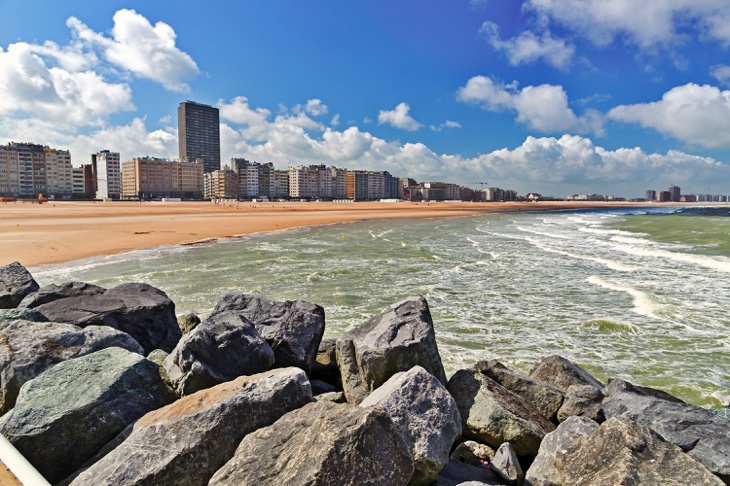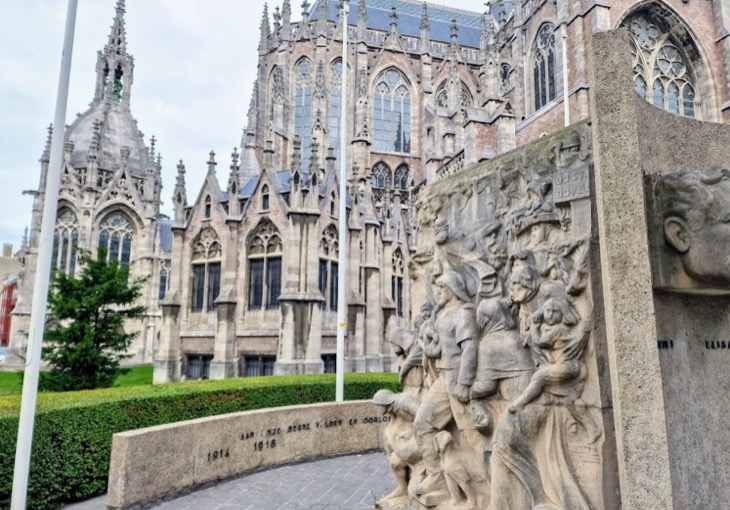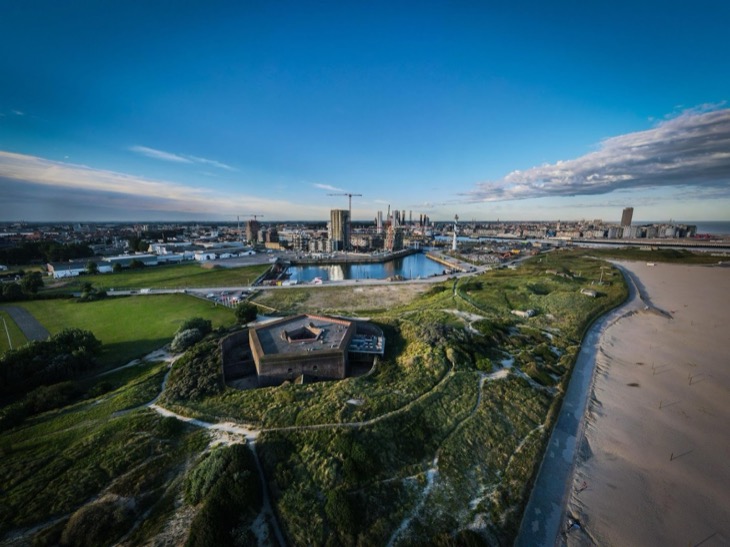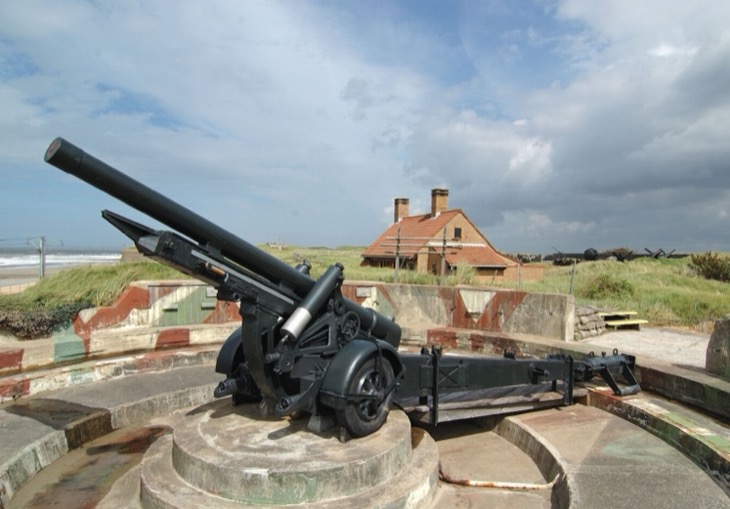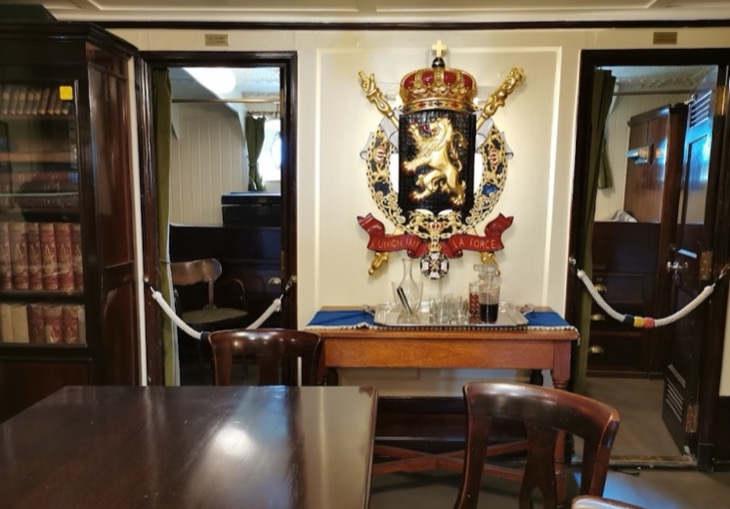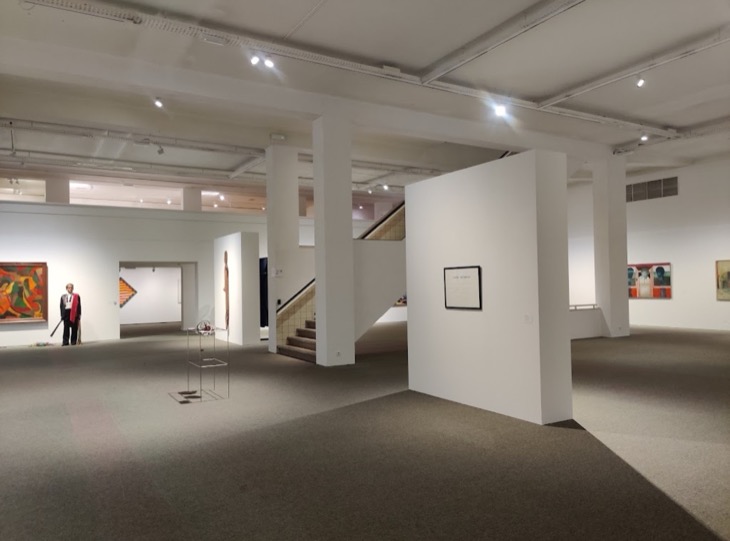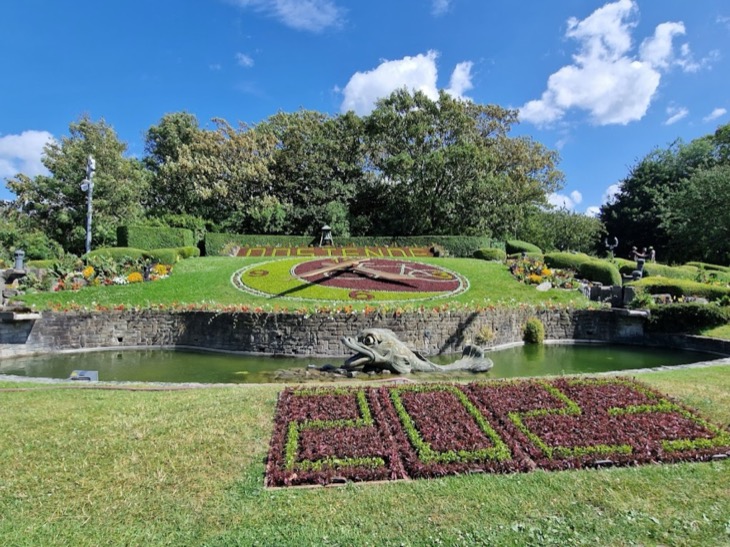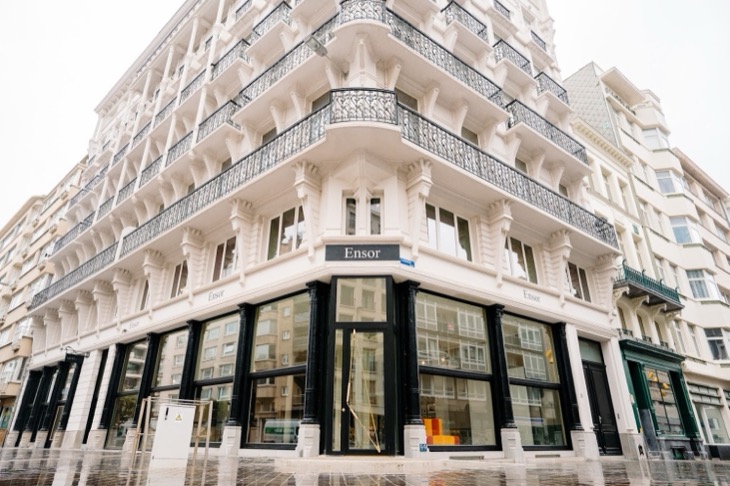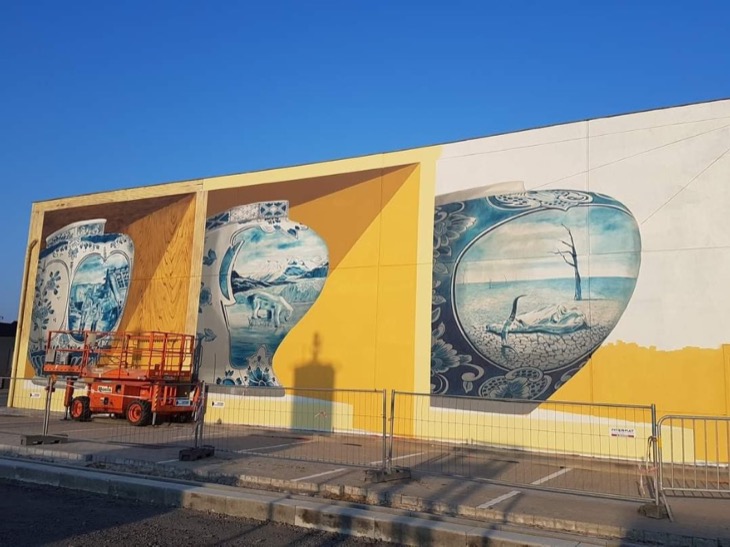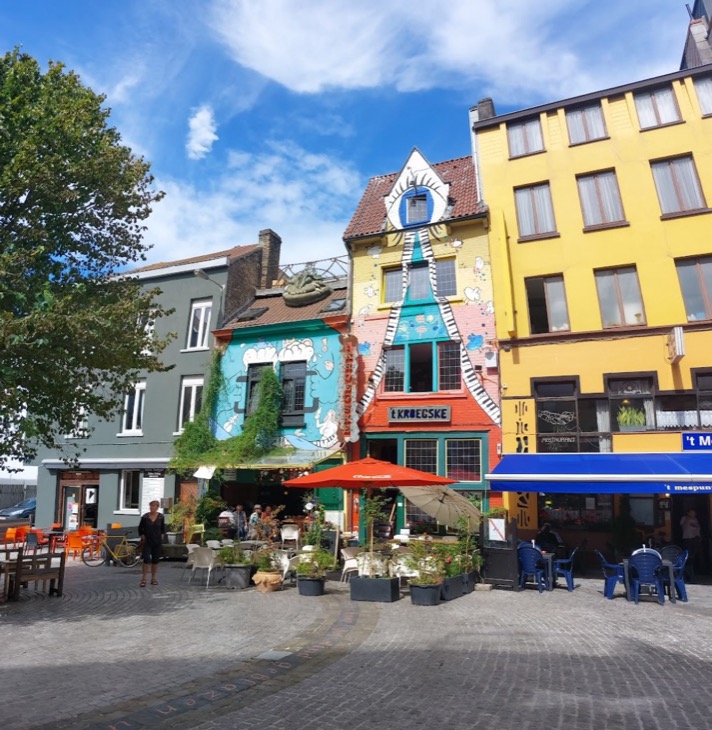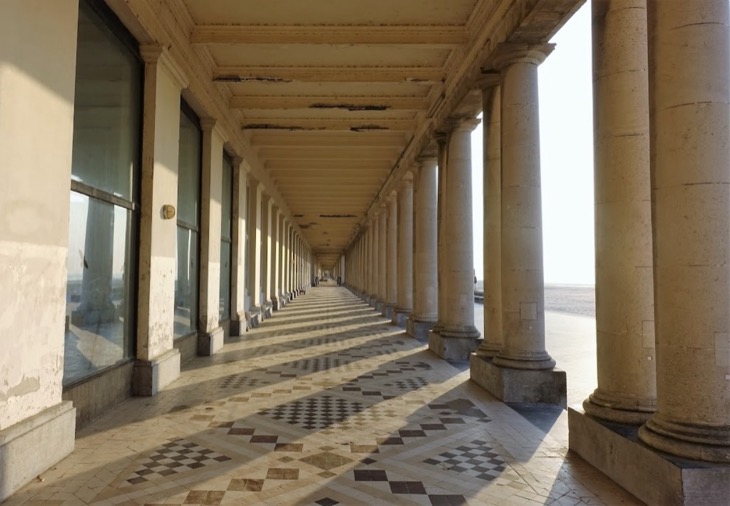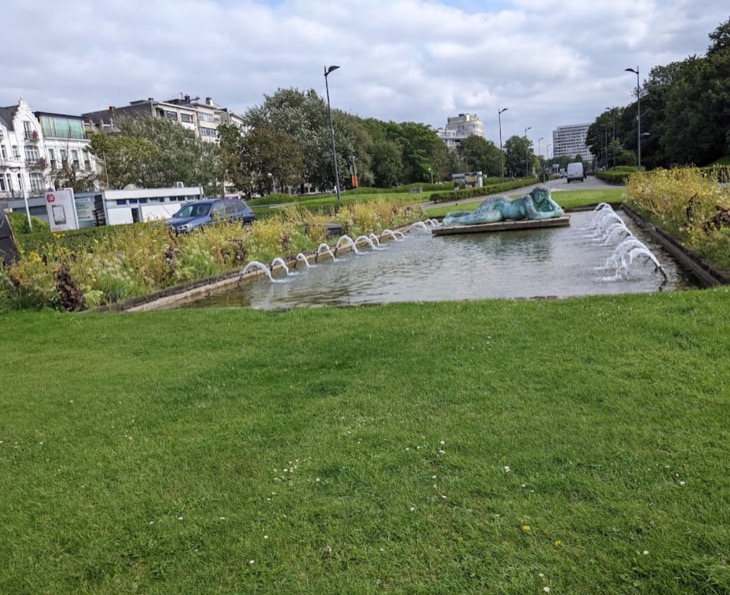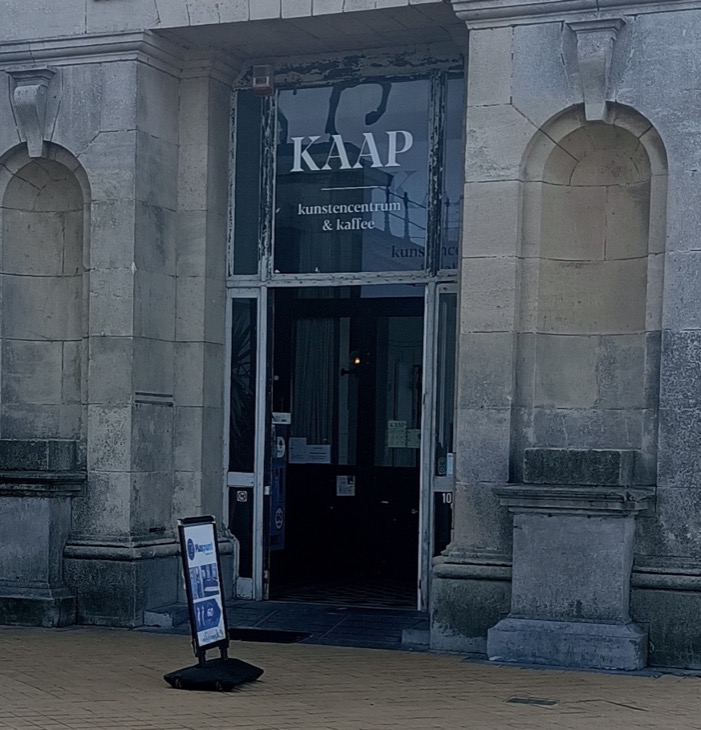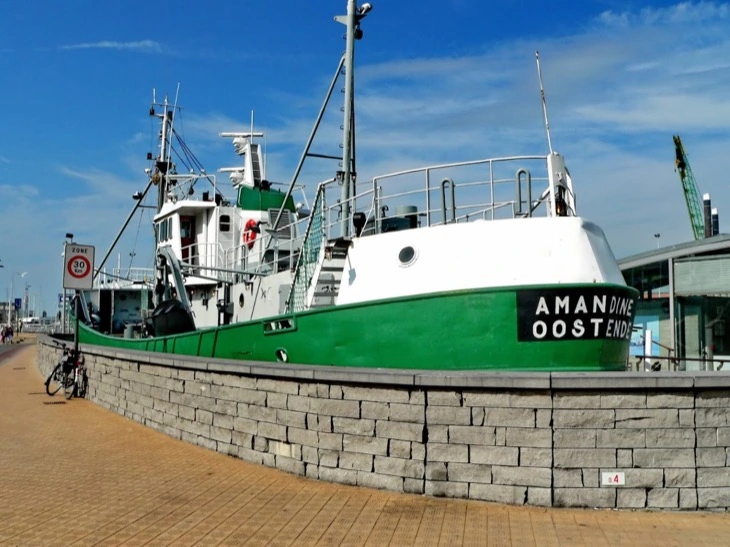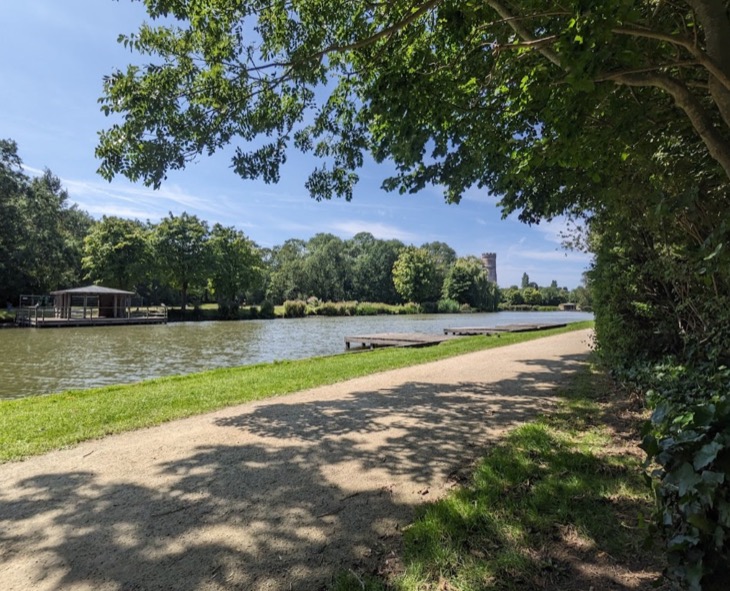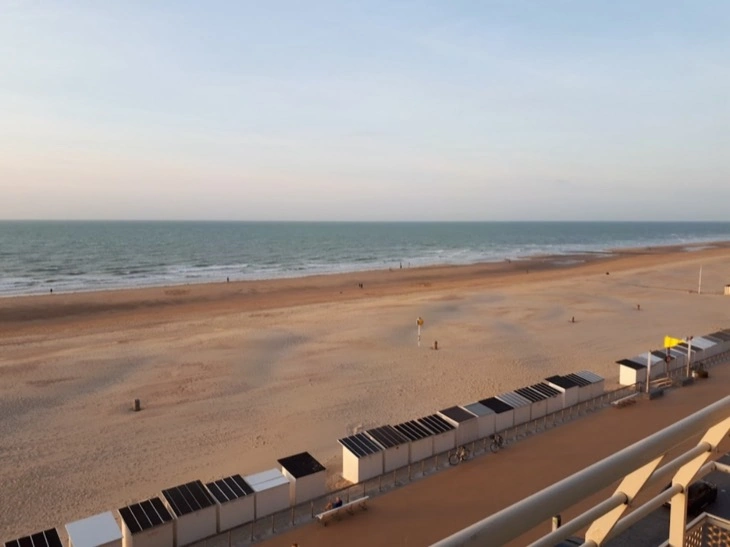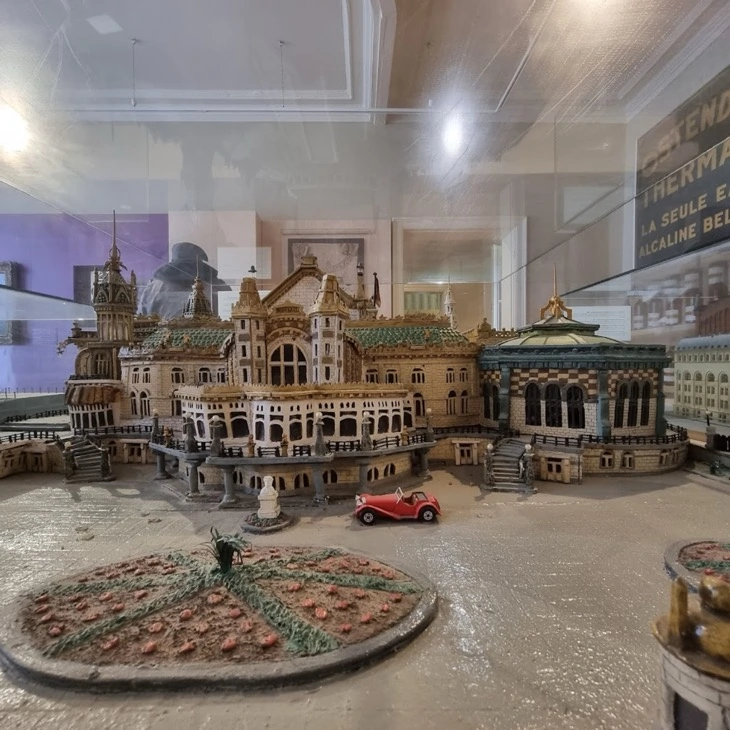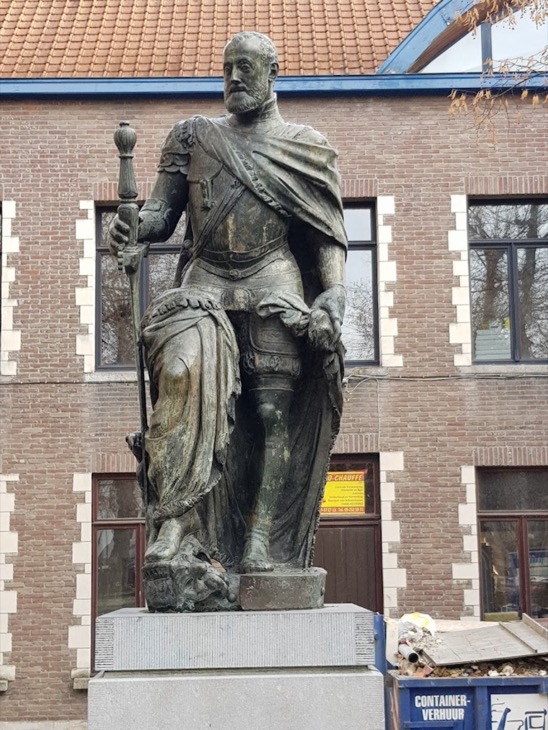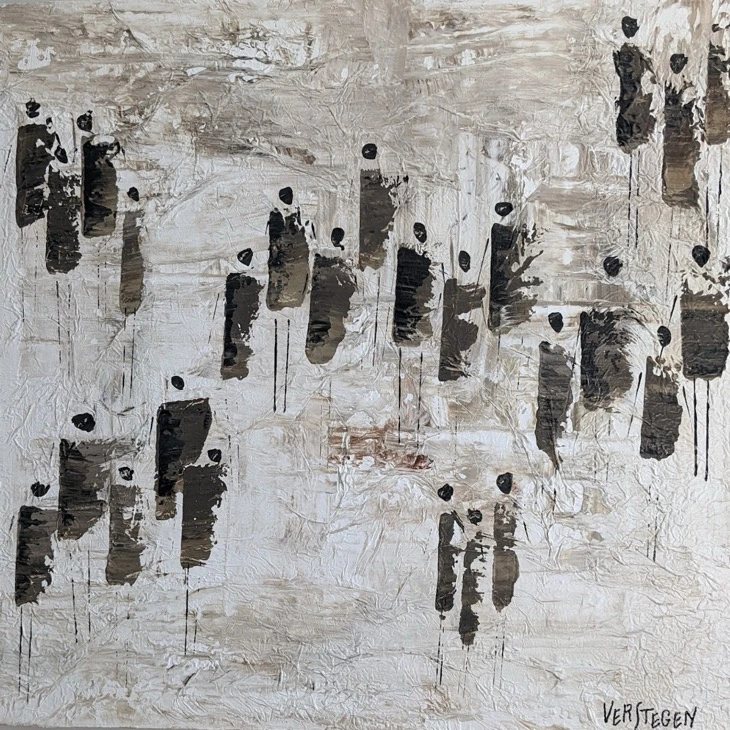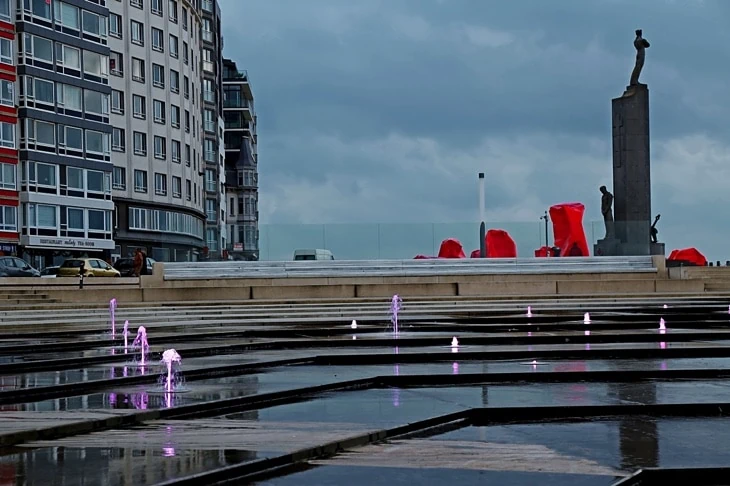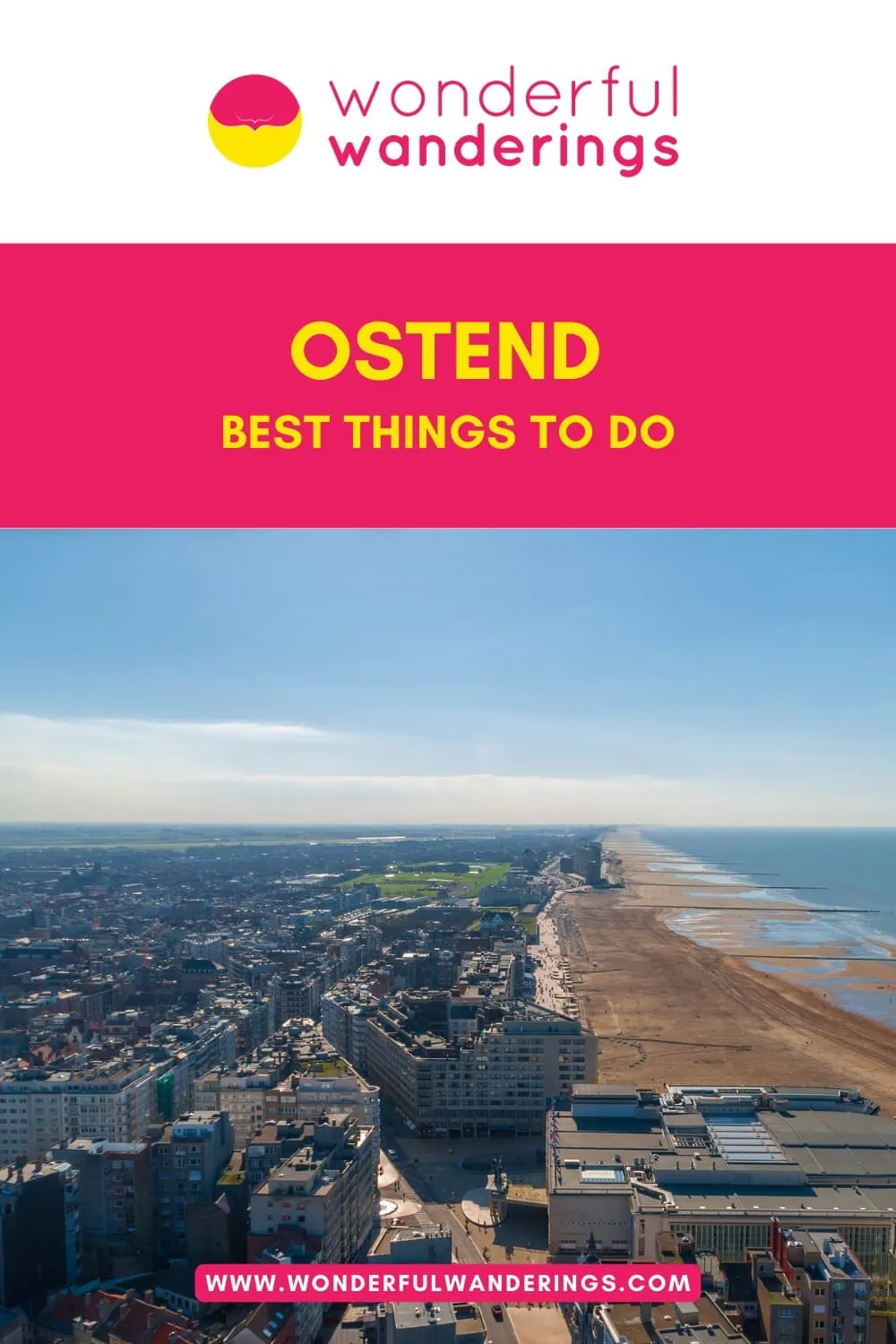Ostend is a coastal city located in the province of West Flanders in Belgium, along the North Sea. Ostend started as a small fishing village in the Middle Ages but grew into an important harbor town by the 17th century. Ostend has been conquered and destroyed numerous times, throughout the ages, basically due to its strategic location, from rebel forces to foreign armies during the Eighty Years War between Spain and the Netherlands. Ostend entered a prosperous period focused around maritime trade, after becoming part of the Austrian Netherlands in the 18th century. The city became a popular seaside resort for Belgian royalty and aristocracy in the 19th century, earning Ostend the nickname “Queen of the Belgian coastal cities”. Though bombed heavily during both World Wars when Germany occupied the city, Ostend rebuilt itself as a significant port town and beach destination.
Today, Ostend is the largest coastal city in Belgium, with a diverse population of around 72,000 inhabitants representing over 130 nationalities. It continues to be a major economic hub supported by tourism, fishing, and its seaport which is Belgium’s biggest port. Ostend also hosts Belgium’s largest beach and draws over 6 million visitors annually to enjoy its sandy shores, historic sites, art museums and seafood cuisine. With such an eventful past and eclectic local culture, Ostend offers many activities and attractions to discover. Visitors can explore remnants of Ostend’s medieval fishing village days, learn about its wartime history, and take in the seaside sights from its expansive beachside promenade. There are historic churches, coastal forts and art museums to experience. Ostend’s modern energy combines with its storied history to create an alluring travel destination.
Listed below are the best things to do in Ostend.
- Visit the Church of Saint Peter and Saint Paul. The Church of Saint Peter and Saint Paul, also known as Sint-Petrus-en-Pauluskerk, is a magnificent neo-Gothic church in Ostend, Belgium that was built between 1899-1908. Designed by architect Louis Delacenserie in the Gothic Revival style, this impressive church has two 72-meter high spires, a beautifully decorated facade with statues and stained glass, and impressive interior features like paintings, sculptures, and a large pipe organ. Visitors can admire the architecture and artwork inside, reflect in the quiet sanctuary, or listen to organ concerts in this early 20th century church.
- Explore Fort Napoleon. Fort Napoleon is a well-preserved, star-shaped Napoleonic fortress located east of Ostend that was built 1811-1814 to defend the harbor against the British. Visitors can explore the fort’s former arsenal, barracks, kitchens and latrines to get a feel for garrison life, and view the World War I murals by German soldier Heinrich Otto Pieper that provide a unique artistic record. Fort Napoleon allows history enthusiasts to walk the ramparts, access the roof for panoramic views, and immerse themselves in Belgium’s 19th century military past.
- See the Atlantikwall. Atlantikwall, also called Atlantic Wall Open Air Museum, preserves over 60 WWII bunkers, posts, artillery and trenches that were part of the German Atlantikwall defenses in Raversijde near Ostend. Visitors can take a self-guided audio tour to explore the well-preserved military structures and learn about life at the fortifications through exhibits displaying uniforms, artillery, and personal artifacts. It provides an immersive glimpse into Belgium’s World War II history.
- Wander through Petit Paris. Petit Paris is a neighborhood in Ostend with remarkably well-preserved belle époque architecture like Art Nouveau, Anglo-Norman and neoclassical buildings from the city’s era as an elite resort. Visitors can take guided walking tours to admire the preserved facades and learn the history, shop and dine among the historic storefronts, and experience Ostend’s luxurious 19th century tourist heyday. The ornate buildings of Petit Paris allow visitors to step back in time and explore the neighborhood’s unique construction during Belgium’s belle époque.
- Ride the Kusttram. Kusttram is a 67 km public light rail route running the length of Belgium’s North Sea coast between France and the Netherlands, offering an easy way to explore the beaches, towns and attractions. Visitors can purchase day passes, hop on and off to visit sights in towns like Ostend, Blankenberge, Zeebrugge and Knokke-Heist, accessing the seafront promenade directly from many tram stops. Riding the entire route, which is the world’s longest tram line, provides lovely seaside views and is a tourist activity in itself.
- Tour the Mercator. The Mercator is a floating maritime museum located in Ostend, Belgium and housed in a restored 1932 Belgian training sailing ship that made 41 voyages around the world. Visitors can explore its authentically preserved decks, cabins, mess hall and bridge to get a glimpse of life at sea over 80 years ago. Exhibits detail the ship’s construction, voyages, and Belgian maritime history through nautical instruments, maps, artifacts, photos and memorabilia.
- See the exhibits at Mu.ZEE. Mu.ZEE is a modern art museum located in Ostend, Belgium uniquely dedicated to showcasing modern and contemporary Belgian art from 1880 to today across a range of movements and styles. Visitors can explore the permanent collection’s galleries of works by famous Belgian artists like James Ensor and René Magritte, as well as special exhibitions focused on certain themes or artists related to Belgian art history.
- Relax in Leopoldpark. Leopoldpark is a beautiful public park located in the heart of Ostend, Belgium that was created between 1860-1870 and features winding paths, flowerbeds, bridges, a lake, a 19th century bandstand, and a famous floral clock. Visitors can go jogging or cycling, have a picnic, relax by the lake, play mini-golf, or simply take in the scenery of trees, ornamental flowers and fountains in this urban green space.
- See the art at the Ensor Museum. The Ensor Museum located in the home where Ostend-born artist James Ensor lived and worked from 1917-1949 features the original furnishings and an exhibition area with displays about his life and work. Visitors can see Ensor’s actual living room and attic studio, view his artworks and carnival masks, and gain insight into his eccentric artistic style through the museum’s setting in his former residence and souvenir shop.
- Admire the street art at The Crystal Ship Festival. The Crystal Ship is Ostend’s annual street art festival that has covered the city with over 50 giant murals and hundreds of pieces since 2016, creating one of Europe’s leading outdoor street art galleries. Visitors can take free walking or cycling tours to view the large-scale pieces spread across building facades, allowing people to explore Ostend’s neighborhoods and discover the harbor, suburbs, and other areas.
Contents
- 1. Visit the Church of Saint Peter and Saint Paul
- 2. Explore Fort Napoleon
- 3. See the Atlantikwall
- 4. Wander through Petit Paris
- 5. Ride the Kusttram
- 6. Tour the Mercator
- 7. See the exhibits at Mu.ZEE
- 8. Relax in Leopoldpark
- 9. See the art at the Ensor Museum
- 10. Admire the street art at The Crystal Ship Festival
- 11. Have a beer at ‘t Kroegske
- 12. Stroll through the Royal Galleries of Ostend
- 13. Take the Marvin Gaye tour
- 14. See the Dikke Mathille sculpture
- 15. Experience KAAP
- 16. Tour the Museumschip Amandine
- 17. Stroll at Maria Hendrikapark
- 18. Try your luck at Casino Ostend
- 19. Unwind at Mariakerke Beach
- 20. Explore Oostends Historisch Museum De Plate
- 21. Learn Memoriaal Prins Karel
- 22. Tour Anno 1465 (Walraversijde)
- 23. View the Verstegen Art Galerie
- What are the best museums to visit in Ostend?
- What are the best activities to do in Ostend with kids and toddlers?
- Where is Ostend?
- What is the history of Ostend?
- How many people live in Ostend?
- What are the most interesting facts about Ostend for tourists?
- What is Ostend famous for?
- How many days should someone spend in Ostend?
- What is the best areas to stay in Ostend?
- What are the best hotels in Ostend?
- What are the best restaurants in Ostend?
- What is the nearest airport in Ostend?
- Is there a ferry to Ostend?
- How to get to Ostend?
- What is the best time to visit Ostend?
- Is Ostend worth visiting?
1. Visit the Church of Saint Peter and Saint Paul
The Church of Saint Peter and Saint Paul, also known as Sint-Petrus-en-Pauluskerk, is a Roman Catholic church located in Ostend, Belgium. The attraction is an impressive neo-Gothic church was built between 1899 and 1908 on the site of a previous church that had been destroyed by fire. King Leopold II was a big supporter of constructing a new, grander church on the ashes of the old one. It was designed by architect Louis Delacenserie in the Gothic Revival style, inspired by the Cologne Cathedral in Germany and the Votivkirche in Vienna. The church stands out with its two 72-meter high spires and beautifully decorated facade containing carved statues and stained glass windows. Inside, visitors are awed by the paintings, sculptures, and especially the large pipe organ.
Visitors to the church can admire the architecture and artwork. They can sit and reflect in the quiet sanctuary or listen to organ concerts. Behind the main altar is the Chapel of Queen Louise Marie containing the tomb of Belgium’s first queen. Her green marble tomb is open to visitors upon request. There is no admission fee to enter the church. The full address of the Church of Saint Peter and Paul is Sint-Petrus-en-Paulusplein, 8400 Oostende, Belgium. The church is located right in the city center of Oostende, about a 5 minute walk from the train station.
The Church of Saint Peter and Paul would appeal to adults interested in religious architecture, history and art. Families would also enjoy visiting this impressive church. It makes a nice outing combined with a trip to Oostende’s beach and seaside promenade. Visitors should dress appropriately out of respect when inside the church. The Church of Saint Peter and Paul is an impressive sight in Oostende. Its grand neo-Gothic architecture and intricate details make it one of the city’s top attractions. Visitors can step inside this beautiful church to admire its artwork and reflect in its peaceful sanctuary. Exploring the history and unique architectural style of this early 20th century church is a highlight when visiting the seaside city of Oostende.
2. Explore Fort Napoleon
Fort Napoleon is a star-shaped fortress located in the east of the Belgian city of Ostend. Fort Napoleon was originally called Fort Impérial when it was built between 1811 and 1814 on the orders of Napoleon Bonaparte to defend the port of Ostend against attack from Britain. The fort is one of the best preserved Napoleonic fortifications in Europe and stands as a reminder of Napoleon’s ambitions to invade England.
The impressive brick-built fortress has five sides, with a central two-storey building surrounded by a dry moat and an eight meter high defensive wall. Inside, visitors can explore the fort’s former arsenal, barracks, kitchens and latrines to get a feel for what life was like for the French garrison stationed there. The fort is now home to a small museum that tells the story of the fort’s construction and military history through information panels, artefacts and audiovisual displays.
One of the most interesting features inside Fort Napoleon is a series of murals painted by German soldier and artist Heinrich Otto Pieper during World War I when the fort was used as a headquarters by occupying German forces. The murals provide a unique artistic record of life at the fort during this period.
Visiting Fort Napoleon today, visitors can walk along the fort’s ramparts and access the roof for panoramic views over the coastline. The on-site cafe provides refreshments and there are regular temporary exhibitions and events held at the fort. It’s an ideal attraction for history buffs and also families, providing an immersive glimpse into Belgium’s military past.
Fort Napoleon is located around 2 kilometers east of Ostend city center, at Vuurtorenweg in the coastal dunes near the harbor. It’s easy to reach via a short walk, bike ride or by local tram to the Duin en Zee stop. Limited parking is available at the fort. Entry costs 9 euros for adults, with discounts available for children, students and groups. Opening hours are 10am to 5pm daily from April to November.
3. See the Atlantikwall
Atlantikwall, known as the Atlantic Wall Open Air Museum, is an open-air museum located in the Provincial Domain of Raversyde near Ostend, Belgium. The museum preserves over 60 bunkers, observation posts, artillery positions, and 2 kilometers of trenches that were part of the infamous German defensive line known as the Atlantikwall built during World War II. Visitors can take a self-guided audio tour to explore the well-preserved military structures and learn about life at the fortifications through exhibits displaying authentic artifacts like uniforms, personal items, and artillery.
Atlantikwall is situated at Nieuwpoortsesteenweg 636, 8400 Oostende in the Raversyde Domain near Ostend on the coast of Belgium. To reach Atlantikwall, one can take the tram which stops right across the street from the museum entrance, or arrive by car with free parking available on site. It’s an excellent attraction for history enthusiasts and World War II buffs, but also suitable for families and visitors of all ages interested in learning about this important period of history.
The standard admission fee is 6 euros for adults, with discounts available for seniors, students, and children under 12 years old who enter for free. The museum is open daily from late March through early November, usually 10:30 AM to 5 PM with last entry at 3:15 PM. Hours are extended during spring and summer months.
Combination tickets can be purchased to also visit the Prince Charles Memorial and the medieval fishing village recreation ANNO 1465 located within the wider Raversyde Domain. Together these three museums provide a glimpse into various eras of Belgian history. A visit to Atlantikwall alone takes around 2 hours. Visitors should wear comfortable shoes for walking, as the outdoor museum requires exploring the bunkers and trenches on foot.
4. Wander through Petit Paris
Petit Paris is a neighborhood in the Belgian city of Ostend located on the North Sea coast. It is part of the city’s western expansion that occurred in the late 19th and early 20th centuries during Belgium’s belle époque period under King Leopold II. The area is known for its eclectic and frivolous belle époque architecture that reflects the wealthy tourism of that era. The neighborhood is also referred to as the Belle Epoque District. What makes Petit Paris special is its remarkably well-preserved collection of ornate buildings from the belle époque years when Ostend emerged as an elite beach resort. The district’s beautiful buildings showcase a diversity of styles including Art Nouveau, Anglo-Norman, and neoclassical. Petit Paris is located in the city of Ostend in the province of West Flanders, Belgium. It stretches along several streets including Alfons Pieterslaan but is centered on the intersection of Torhoutsesteenweg and Nieuwpoortsesteenweg. Ostend is approximately 64 kilometers (40 miles) from Bruges and 129 kilometers (80 miles) from Brussels.
Visitors to Petit Paris can take a guided walking tour to admire the preserved architecture. The guides from the local Gidsenkring De Lange Nelle organization offer tours that tell the history behind the neighborhood’s construction and identify noteworthy facades. Walking through Petit Paris allows visitors to step back in time to the luxurious heyday of 19th century European beach tourism.
In addition to guided tours, visitors can explore Petit Paris on their own, shopping and dining among the preserved historic storefronts and buildings. The district holds events like the annual Belle Epoque Shopping Day when local businesses celebrate the heritage with special promotions and activities. Visitors can also stop into the landmark Le Châtelet building on the corner of Nieuwpoortsesteenweg and Torhoutsesteenweg to see an ornate preserved interior from the era.
Visitors can take the train or bus to Ostend. The city has a central railway station with frequent service. Buses traveling between nearby cities also stop in Ostend. Once in the city, Petit Paris can be reached in about 10-15 minutes by local tram, bus, taxi, or bicycle. Walking takes around 30 minutes from the city center.
Petit Paris appeals to adults interested in history, architecture, and Belgian culture. Families traveling with older children can also appreciate exploring the neighborhood’s well-preserved buildings. There is no admission fee to walk through Petit Paris and admire the architecture. Guided walking tours have a small fee around €3.50 per person.
5. Ride the Kusttram
The Kusttram is a public light rail transit service connecting the cities and towns along the Belgian coast of the North Sea, between Adinkerke near the border with France and Knokke-Heist near the border with the Netherlands. Kusttram is currently the longest tram route in the world and the second-longest light rail service in the world after the Rhein-Ruhr Stadtbahn in Germany. Kusttram route is 67 kilometers (42 miles) in length across 67 stops and is considered one of the few tramways in the world that has remained consistently in operation since 1885. The Kusttram is sometimes referred to by its line number, Tram Route 0. It is also nicknamed the coastal tramway in English or “de Kusttram” in Dutch.
The Kusttram route is operated by De Lijn, the main public transit operator for the Flanders region of Belgium, and runs almost entirely parallel to the coastline, with trams departing up to every 10 minutes during peak summer hours. The service makes stops at the majority of towns and cities along the coast, including Koksijde, De Panne, Nieuwpoort, Middelkerke, Ostend, Blankenberge, Zeebrugge, Knokke-Heist and others. This allows visitors easy access to the beaches, restaurants, shops, museums and attractions all along the coast of Flanders without needing a car.
The Kusttram, as the longest tram route in service in the world, is spanning the entirety of the Belgian coastline is a unique and efficient way to explore the beaches, seaside towns and attractions of the Flemish coast. The service has been in continual operation since 1885, preserving an important piece of Belgian transport history. Riding the Kusttram is a tourist activity in itself, providing lovely seaside views from its windows as it travels from town to town.
Visitors can purchase single ride tickets or day passes and hop on and off as much as they like to explore the towns along the coast. The Kusttram can be accessed at any of its 67 stops along the coast between Knokke-Heist and De Panne. Major stops with parking, bus and train connections include the Knokke-Heist station, Blankenberge station, Ostend station and De Panne station. Tickets can be purchased at ticket machines located at the stops, in advance online, or through the De Lijn app.
The Kusttram is popular with tourists and locals alike as it provides an easy way for visitors to access the major sights, attractions, things to do, activities and museums without a car. Locals also use it for daily commuting. The Kusttram is great for travelers, families, groups of friends, solo travelers and anyone looking to relaxingly explore the Belgian seafront. Kusttram fares are quite affordable. A single ride ticket costs 2.50 euros. Day passes allowing unlimited rides along the full route cost 7.50 euros. Discounted rates are available for children and youth under age 26. Kids under age 6 ride for free.
6. Tour the Mercator
Mercator, also called as School Ship Mercator or Zeilschip Mercator, is a floating maritime museum located in Ostend, Belgium. Mercator’s full address is Vindictivelaan 1, 8400 Oostende, Belgium. Mercator was built in 1932 in Scotland as a training vessel for the Belgian merchant fleet and made 41 voyages around the world, participated in scientific expeditions and races. The ship’s unique journeys included transporting Moai statues from Easter Island to Europe and bringing the remains of Father Damien back from Molokai, Hawaii to Belgium in 1936.
After serving in the British Navy during World War II, Mercator returned to Belgium in 1947 and resumed service as a training ship until 1960. Since 1961, it has been a floating museum, first in Antwerp and then permanently in Ostend as of 1964. The interior has been preserved in its original state, providing visitors with an authentic glimpse of life on board.
Visitors to Mercator can explore the ship’s decks, cabins, mess hall, and bridge. Exhibits detail the ship’s construction, its voyages, life at sea, and Belgian maritime history. Guests can view nautical instruments, maps, artifacts from expeditions, historical photos, documents, and memorabilia. Visitors can read the information panels in Dutch, French, English and German.
Mercator is easily accessible in downtown Ostend, about 300 meters from the train station. It can also be reached by car, with parking available nearby. The museum is open daily except Mondays from 10am to 5pm. From November to March, it is only open on weekends.
The ship museum appeals to adults and families interested in maritime history, life at sea, Belgium culture, and unique museums. The authentic interior and artifacts provide an educational experience. Admission is 7 euros for adults, 5 euros for children 6-11, and free for kids under 6.
7. See the exhibits at Mu.ZEE
The Mu.ZEE is a modern art museum located in Ostend, Belgium at Romestraat 11, 8400. The museum is also known as the Kunstmuseum aan Zee, which translates to “Art Museum at the Sea” in Dutch. Mu.ZEE is the only museum in the world that focuses specifically on modern and contemporary Belgian art from 1880 to the present day, has a beautiful and expansive collection of over 8.000 works, including many key pieces by famous Belgian artists such as James Ensor, Léon Spilliaert, and Constant Permeke. Beyond just displaying artwork, Mu.ZEE aims to share knowledge about Belgian art history and inspire visitors to engage actively with the rich cultural heritage.
Visitors to the Mu.ZEE can explore several floors of gallery space showcasing the permanent collection. Mu.ZEE’s displays change periodically allowing repeat visitors to experience new perspectives. Mu.ZEE also hosts temporary exhibitions focused on various artists, themes or movements in Belgian art. Recent special exhibitions have highlighted impressionist Anna Boch and surrealist Raoul Servais. Mu.ZEE also offers public programs like lectures, concerts, and hands-on art workshops.
Mu.ZEE is located within a 15 minute walk from the train station in downtown Ostend. Mu.ZEE welcomes diverse audiences of all ages and backgrounds as there is plenty exhibits for both art enthusiasts and casual visitors to enjoy. Admission costs 15€ for adults, while children under 12 enter for free. Special discounted rates are available for youth from 13-25 years old (3€) and groups of 15 or more people (13€ per person).
Mu.ZEE is closed on Mondays, and open from Tuesday to Sunday from 10am to 5:30pm. The museum is also closed on Christmas Day and New Year’s Day.
8. Relax in Leopoldpark
Leopoldpark, also known as “Den hof”, is a public park located in the city center of Oostende, Belgium. It is a 5-hectare park that was designed in the style of an English landscape garden, with winding paths, flowerbeds, bridges and a lake. The park was created between 1860-1870 on the site of the old city fortifications.
The full address of Leopoldpark is Leopold II Laan, 8400 Oostende which is right next to the Kursaal Casino and Congress Center, and about 500 meters from the beach and Ostend railway station. The park can easily be reached on foot if staying in the city center, or is a short drive from elsewhere in Oostende. There is metered street parking available nearby.
The highlights of Leopoldpark include a beautiful 19th century bandstand, a famous floral clock installed in 1933, and several statues and fountains scattered throughout the grounds. The floral clock has a diameter of 9 meters and is planted with over 30,000 flowers each year. The park also contains mature trees, including a 250 year old cherry tree, as well as ornamental flower beds. Visitors to Leopoldpark can enjoy walking or jogging on the paths, having a picnic, reading a book, or simply relaxing and taking in the scenery. One of the most popular activities is the 21-hole mini-golf course located next to the lake. There is also a cafe in the park serving drinks and light meals. The park often hosts events like concerts, festivals and exhibitions.
Leopoldpark is suitable for visitors of all ages and makes an ideal spot for families, couples, solo travelers or groups of friends. It provides a green oasis and place to unwind in the middle of the city. Admission to the park is free and it is open 24 hours a day, though some caution is advised after dark when it is less populated. The floral clock and mini-golf course do charge a small fee.
9. See the art at the Ensor Museum
The Ensor Museum, also known as Het James Ensorhuis, is located in Ostend, Belgium at Vlaanderenstraat 29. Ensor Museum is dedicated to the Ostend-born painter James Ensor. Visitors can explore the house where the artist lived and worked from 1917 until his death in 1949. The museum contains Ensor’s original furnishings, including the souvenir shop run by his aunt and uncle on the ground floor. Upstairs, an exhibition area has interpretive displays about the artist’s life and work. Highlights include recreations of Ensor’s blue living room and his attic studio. Many of his artworks and carnival masks are on display throughout the museum.
Ensor was known for his eccentric paintings filled with skeletons, masks, and fantastical imagery. The museum’s setting in his former home and family souvenir shop provides insight into the origins of Ensor’s distinctive style. At Ensor Museum, visitors can take a guided audio tour to learn about the artist’s life and see the rooms where he lived and worked. Displays with text and images chronicle Ensor’s career from his youth in Ostend through his struggles for acceptance and eventual fame. Seeing his artworks and possessions up close gives a sense of his creative process and personality. Visitors can also view documentary footage about Ensor’s life in Ostend.
The museum is located right in Ostend city center, about a 12 minute walk from the train station. It is easily accessible for visitors arriving by train from Brussels, Antwerp, Bruges, or other Belgian cities. For visitors arriving to the museum by car, parking is available at nearby locations like the Casino or Wellington hippodrome.
Ensor Museum appeals most to visitors with an interest in art history, especially Belgian modernists and Expressionism. It provides useful background to better understand and appreciate Ensor’s significance. Visitors of all ages can enjoy the museum, but some maturity is helpful for grasping the art historical context.
Entry to Ensor Museum costs 12 EUR ($12.50, £10) for adults. Special rates are available for seniors, students, children, and groups. On Sundays between October and March, admission is free during certain hours.
10. Admire the street art at The Crystal Ship Festival
The Crystal Ship is an annual street art festival held in Ostend, Belgium. The festival started in 2016 and has transformed Ostend into one of Europe’s leading open-air street art galleries. The Crystal Ship Street Art Festival was founded by Bjørn Van Poucke and brings renowned street artists from around the world to Ostend each year to create large-scale murals and art installations throughout the city. The artworks become a permanent part of Ostend’s public art collection and can be seen year-round in an evolving outdoor gallery.
The Crystal Ship is one of the largest street art festivals in Europe, with over 50 giant murals and hundreds of smaller pieces created since 2016. The festival has brought artists like Roa, Jaune, Ella & Pitr, and Faith47 to Ostend to paint striking and often socially-conscious works across building facades. Many interact with their surroundings or portray people and themes relevant to the local community.
Visitors to Ostend can take self-guided walking or cycling tours to view the murals and artworks spread throughout the city center and outskirts. Maps can be picked up for free from the Ostend tourism office showing the locations of all the pieces, which cover over 25 kilometers. Some top works to see include the giant murals by Guido Van Helten, ROA, Jaune, and Fintan Magee. Going between the pieces allows you to explore Ostend’s neighborhoods and discover spots like the harbor, Stene suburb, and Atlantikwall.
There is no cost to view the outdoor murals, so it is a budget-friendly activity. The festival and artwork can be appreciated by art enthusiasts, families, students, or those simply interested in urban culture. Each spring, The Crystal Ship festival adds new murals and art interventions, keeping the outdoor gallery evolving. Visiting Ostend during the festival itself offers a lively atmosphere and the chance to see artists at work. But the street art can be viewed year-round, providing a colorful and unexpected side to Belgium’s historic beachside town.
11. Have a beer at ‘t Kroegske
‘t Kroegske is a small, colourful café located at Sint-Paulusstraat 80, 8400 Oostende, Belgium. ‘t Kroegske is sometimes referred to as “the little bar” by locals. The interior is also filled with curiosities and works of art, creating a funky atmosphere. Visitors to ‘t Kroegske can enjoy a drink in the cozy setting. The bar serves a variety of Belgian beers, as well as coffee, wine, and spirits. Customers can sit at the small bar inside, on the balcony overlooking the bar, or at tables outdoors when the weather is nice. Live music is sometimes performed in the cramped space, adding to the ambiance. The owner, Iwein Scheer, has been running ‘t Kroegske for over 50 years and is known for his gregariousness. To get to ‘t Kroegske, visitors can take the tram or bus to the vicinity of Sint-Paulusplein in central Ostend, then walk for just a couple minutes to reach the café. ‘t Kroegske is open Tuesday to Sunday from 11am to 2pm and 6pm to midnight. The café is best suited for adults looking for an authentic local watering hole. Kids may find the artsy décor amusing. There is no admission fee to enter ‘t Kroegske.
‘t Kroegske played an instrumental role in founding the famous Paulusfeesten, an alternative arts festival held annually in Ostend. The quirky charm and welcoming vibe of ‘t Kroegske makes it a must-visit in Ostend for both locals and tourists interested in experiencing Belgian culture.
12. Stroll through the Royal Galleries of Ostend
The Royal Galleries, also known as Koninklijke Gaanderijen, are a magnificent neoclassical seaside arcade located on the seafront promenade of Ostend. The galleries are located along the beaches of the North Sea, connect the former royal villa to the Wellington Hippodrome horse racing track and the address is Albert I-Promenade in Ostend 8400, Belgium.
Royal Galleries, built between 1902 and 1906, stretch approximately 381 meters long with a colonnade of 343 paired Tuscan columns, each column resting on a bluestone pedestal. The columns support an ornate entablature decorated with triglyphs and projecting corbels. At each end of the galleries stand two stately pavilions, one octagonal salon facing the beach and another anchoring the opposite end.
The galleries were designed by the French architect Charles Girault and were commissioned by King Leopold II to shelter the monarch and his guests on their promenade from the beach to the racetrack. The glass ceiling and lateral glass partitions originally had iron grilles for protection from the harsh North Sea winds. Sadly the grilles were removed and melted down during World War I.
Visitor can stroll through the Royal Galleries and admire the soaring corridors lined with neoclassical columns and arches. Sunlight filters through the glass ceiling and sparkles on the ocean visible through the partitions. At night, the galleries take on a more haunting atmosphere as depicted in many paintings by Belgian symbolist artist Léon Spilliaert. The long rows of arches create intriguing perspectives, popular with photographers.
The galleries host temporary art exhibitions and photography displays along one side. They also frame views of the grand Thermae Palace Hotel, built in 1933 in the Art Deco style. The hotel still retains its stately Belle Époque character, despite some dilapidation over the years. The Royal Galleries attract sightseers of all ages interested in Ostend’s history and seaside architecture. They also draw visitors wanting to walk the full length of the seafront promenade from east to west. The galleries are wheelchair accessible at the main entrance.
Admission to enter and stroll through the Royal Galleries is free and are open year-round. They are exceptionally atmospheric on a stormy day when the wind and waves crash against the colonnade.
The galleries are easiest to reach on foot if staying nearby or arriving by tram, which stops right across the street on Koningin Astridlaan. Limited pay parking is available along the seafront roads. For visitors traveling from further afield, Ostend can be reached in just over an hour’s drive from Brussels or under 30 minutes from Bruges. It’s also about a 10 minute drive from Ostend-Bruges International Airport.
13. Take the Marvin Gaye tour
The Marvin Gaye Midnight Love Tour is an walking tour in Ostend, Belgium that takes visitors to sites related to the American soul musician Marvin Gaye. The singer-songwriter came to Ostend in February 1981 at the invitation of concert promoter and hotel owner Freddy Cousaert, looking for respite after years of personal and professional difficulties. Though intended as a brief stay, Gaye remained in Ostend for nearly 18 months, living a low-key existence and composing music that would appear on his 1982 comeback album Midnight Love, including the hit single “Sexual Healing”.
The Marvin Gaye Midnight Love Tour allows participants to walk in the musician’s footsteps, listening to an audio guide with narration and interviews on a smartphone. It starts at the Visserskaai dock where Gaye arrived by boat, then goes past the building where he lived at Residentie Jane 77 on Albert I Promenade. Other stops include the Groove bar where he would sometimes perform, the sea wall he jogged along for exercise, and the Church of Our Lady of Lourdes where he would pray. The tour concludes at the Kursaal Ostend casino and concert hall, where Gaye staged several performances in 1981 and filmed the music video for “Sexual Healing”.
The self-guided Marvin Gaye Midnight Love Tour takes 1-2 hours and costs €5.49 per person. Participants can rent an iPod loaded with the tour audio and videos at the Ostend tourist information office on Monacoplein in the city center. The audio guide combines narration about Gaye’s time in Ostend with archival interview clips and footage of the musician, providing insight into his everyday life in the seaside town.
The tour is best suited for fans of Marvin Gaye or those interested in music history, as it explores an unusual phase late in the singer’s career. Visitors to Ostend looking for a creative way to explore the city and learn about Gaye’s time there would also appreciate the tour. With stops at several bars and historic sites, it provides a compelling look at the artist’s self-imposed exile from the excesses of Los Angeles and the creative rebirth he experienced in Ostend.
14. See the Dikke Mathille sculpture
The Dikke Mathille sculpture is a famous bronze statue located in Ostend, Belgium. Also known as “The Sea” and “Liggend Naakt”, this artwork depicts a voluptuous reclining nude woman. It was designed by Belgian sculptor Georges Grard and placed in Ostend’s Leopold Park in 1955. Grard deliberately emphasized the curves and full figure of the female form. The free-flowing hair also captures the motion of ocean waves. Initially, the provocative nature of the nude sculpture generated controversy. Some considered it indecent, while others recognized its artistic merit. Ultimately, the popularity of the Dikke Mathille earned it the status of a symbol for the liberal spirit of Ostend.
Visitors can view and photograph the Dikke Mathille sculpture up close when walking through Leopold Park. The statue sits in the center of a pond, nestled amongst the trees and greenery. People enjoy discussing the irony of the sculpture’s modest nickname of “Fat Mathilde” in contrast to her realistic rendered nude form.
People of all ages are drawn to the mystique and beauty of the Dikke Mathille sculpture. Her story sparks interesting conversations from art enthusiasts to families. There is no cost to access Leopold Park and view the artwork. The Dikke Mathille has become a symbol of Ostend’s openness and artistic spirit. Her form represents freedom and appreciation for the human body.
15. Experience KAAP
KAAP, also called “Vrijstaat O.”, is a cultural center and art space located in Oostende, Belgium. The full address of KAAP’s Oostende location is Zeedijk, Koning Boudewijnpromenade 10, 8400 Oostende. KAAP is the first regional arts center in Flanders, formed by merging the former art centers Vrijstaat O. (Oostende) and De Werf (Bruges). KAAP has brought these two art centers together to work in two cities on four artistic disciplines – music, stage, literature, and visual arts – with a focus on providing a platform for artists and organizing creative festivals, since 2017.
Visitors to KAAP Oostende can enjoy the seaside cafe, which offers drinks, light meals, and baked goods. The cafe has outdoor seating with views of the beach and sea. KAAP also hosts music performances, literary events, exhibitions, and more in its indoor spaces. Some events at KAAP are free while others require purchased tickets. KAAP Oostende is located right on the seafront promenade in Oostende, so it is easily accessible by foot for those already exploring the city center and beach. For visitors coming from farther away, Oostende can be reached by train, with the nearest station about 1 km away from KAAP.
The cultural events and exhibitions at KAAP appeal to adults interested in the arts, music, and literature. The seaside cafe attracts a broad audience of locals and tourists. Admission to the cafe is free, while ticket prices for performances and events vary depending on the artist or show.
16. Tour the Museumschip Amandine
Museumschip Amandine is an interactive museum located at Vindictivelaan 35-z in Oostende, Belgium. It is housed in a restored fishing trawler called the O.129 Amandine, which was the last Icelandic fishing vessel operating out of Oostende. The Amandine fished the dangerous waters around Iceland for over 30 years until it was decommissioned in 1995. After sitting idle for several years, the city of Oostende purchased the trawler and converted it into a museum focusing on the history of Belgian fishermen who braved the frigid seas around Iceland in search of cod, haddock and other species.
The museum opened to the public in 2000 after two years of meticulous restoration work. Visitors can tour the authentically restored decks, fish hold, cabins and engine room of the trawler. Using state-of-the-art audiovisual displays, the museum recreates the sights, sounds and even smells of life aboard an Icelandic fishing vessel. Lifelike mannequins representing the crew, coupled with ambient sounds of the ship’s engine and the sea, make visitors feel as if they are actually sailing the rough seas of the North Atlantic.
Museumschip Amandine complex includes a recreated street scene from Oostende’s historic fishing quarter in the 1960s. The cobblestone street features replicas of shops, a café and even a brothel that fishermen frequented during their brief stays on shore between voyages. Amandine offers visitors a vivid look into the hardships, dangers and camaraderie experienced by generations of Belgian fishermen who embarked on months-long expeditions to Iceland’s perilous but bountiful waters. During Oostende’s heyday as a fishing port, more than 80 trawlers made up the so-called Iceland Fleet. Braving frequent storms and frigid temperatures, the fleet’s hardy crews battled 30-foot waves and ice buildup to haul in their catch. It was difficult, dangerous work that claimed many lives over the decades.
The museum is ideally suited for seniors, adults, children and toddlers interested in Belgian maritime history and culture. Visitors should allow 1-2 hours to fully experience the museum’s exhibits and historical ambiance. Museumschip Amandine is open Tuesday-Sunday from 10am to 5pm. Admission is €7 for adults, while children under 12 and students up to age 26 receive discounted tickets. Guided tours are available for groups of 20 or more at a reduced rate of €6 per person.
Museumschip Amandine can be easily reached by public transportation, as it sits adjacent to Oostende’s railway station. The museum is within walking distance of downtown Oostende’s shops, restaurants and beaches. Visitors leaving Oostende can also catch the ferry to Dover, England just across the harbor from the museum.
17. Stroll at Maria Hendrikapark
Maria Hendrikapark, also known locally as ‘t Bosje (the Little Forest), is a 37 hectare public park located in the heart of Oostende, Belgium. Maria Hendrikapark can be found at Platanendreef 1-2, 8400 Oostende, between the railway zone to the east, the Stene district to the south, the Verenigde Natieslaan to the west and the Hazegras district with its barracks to the north.
Maria Hendrikapark was created between 1888 and 1892 on the request of King Leopold II, who originally wanted to name it Bois de Boulogne after the famous landscape park on the outskirts of Paris. It was named after Leopold’s wife Queen Maria Hendrika. The landscape architect Eduard Keilig drew up the first plans for the park in 1876, using a previously wild and overgrown wooded area just outside the old city walls near the barracks as a basis.
Over the years, Maria Hendrikapark has been a popular recreation area for the people of Oostende and visitors alike. It has walking trails that lead through shady woodlands, open fields and along three ponds, each with its own unique character. The Koninginnevijver is focused on relaxation, with opportunities for fishing, boating and picnicking. The Spiegelmeer has a formal, symmetrical landscape where the vegetation is strictly contained. The area around the Konijnevijver is more wild, where nature is allowed to take its course.
The park features ponds, two playgrounds for children, a cafe and restaurant, a traffic park with go-karts and a miniature golf course. Between 2003-2006, an extensive renovation project upgraded the paths, entrances, accessibility and ecology of the park. Cars were also banned from most of the interior roads and paths, reclaiming spaces for nature.
Maria Hendrikapark offers something for visitors of all ages and interests. Families especially appreciate the playgrounds, traffic park and boating options. There is a cafe in the middle of the main pond, which is a popular spot to stop for a drink or meal while exploring the park. Joggers and cyclists enjoy exercising on the 5 km looped trail that winds through the park. Nature lovers can take a stroll to appreciate the diverse tree species and wildlife.
The park can be easily accessed on foot or by bike from Oostende city center, which is less than 2 km away. For visitors arriving by car, there is a free parking lot next to the main entrance on Iependreef. The park is open 24 hours a day, 7 days a week and admission is free.
18. Try your luck at Casino Ostend
Casino Oostende, also known as Casino Kursaal Oostende, is located at Kursaal-Oosthelling 12, 8400 Oostende. Casino Oostende is the largest casino in Belgium with a gaming area spanning over 25,000 square feet. It offers a wide range of gambling options including 200 slot machines, 33 table games like American Roulette, Blackjack and Poker as well as regular Texas Hold’em poker tournaments. The casino is open 24 hours a day, 7 days a week.
The casino is housed in the Kursaal building which was built in the 1950s in a modernist style right on the beach promenade. The Kursaal building has been an entertainment complex and casino for over a century now, making it an iconic landmark in Oostende. The casino’s gaming rooms feature ornate decor, chandeliers and paintings by Belgian surrealist artist Paul Delvaux.
Visitors to Casino Oostende can try their luck at the slot machines or table games. The casino hosts poker tournaments, game events and live music performances. There is a restaurant called Brassi inside the casino which serves French cuisine and has a wonderful view of the North Sea. The casino complex houses a concert hall, exhibition spaces and conference rooms as well that can be rented out for private events.
Casino Oostende can be easily accessed by car, public transport or on foot. The casino is located right on the beach promenade and is walking distance from the city center, the train station and several hotels. For those driving, there is public parking near the casino. The nearest airport is Ostend-Bruges International Airport which is 5 km away.
The casino provides entertainment for adults over the age of 21. The minimum age required for entry is 21 years and visitors need to present a valid ID. There is no entrance fee to enter Casino Oostende and access to the gaming area is free. The games themselves require Money to Play. The slot machines accept coins from €0.01 to €2 and table games like roulette and blackjack have minimum bets starting from €2.
19. Unwind at Mariakerke Beach
Mariakerke Beach, also known as Strand Mariakerke Bad, is a popular sandy beach located in the Mariakerke district of Ostend. Mariakerke Beach stretches for over 2 kilometers along the North Sea coastline. Mariakerke Beach is an ideal destination for families with young children. The beach offers plenty of space to spread out and unwind, even on the hottest summer days. Lifeguards are on duty during peak seasons to ensure safety. Various amenities like public toilets, outdoor showers, small restaurants, and ice cream shops line the sandy shores. The beach is easily accessible by tram, with a stop located right by the main entrance. Parking is also available nearby. The main entrance located near the intersection of Zeedijk and Duinenstraat. Visitors can access the beach promenade directly from the tram stop Mariakerke Bad.
Mariakerke Beach is accessed free of charge and open to the public year-round. However, parking fees apply in peak summer months. The beach and its facilities are best suited for families, couples, solo travelers, and seniors looking to relax. Surfers and water sports enthusiasts will also enjoy the waves and rental options. Leashed dogs are allowed in specific zones during off-season months.
Popular activities at Mariakerke Beach include swimming, sunbathing, beach volleyball, surfing, building sandcastles and beachcombing. The calmer waves make it a nice spot for stand up paddleboarding and kayaking. Fishing is allowed in designated zones. The city organizes events like concerts, dance parties and movies on the beach, during summer months.
20. Explore Oostends Historisch Museum De Plate
Oostends Historisch Museum De Plate is a local history museum located in Langestraat 69, 8400 Oostende, Belgium. The museum, also known as the Oostend Historical Museum De Plate or the City Museum Ostend, is housed in a late 18th century royal residence that served as the summer home of King Leopold I and Queen Louise-Marie. Louise-Marie was the first Belgian queen and she died in this building in 1850. Her restored bedroom where she passed away can still be visited today.
Oostends Historisch Museum De Plate showcases the rich history and maritime heritage of Ostend through artifacts, models, artwork, photographs and multimedia displays. Key themes represented at the museum are urban development, tourism, fishing, the harbor and shipping. Some highlights of the museum’s collection include ship models depicting Ostend’s fishing fleet over the years, a reconstructed 1900 fisherman’s living room and pub, artifacts from the fish market and lighthouse, seaside souvenirs and posters from the belle époque period, and works by local artists like James Ensor.
Visitors to the museum can explore the permanent collection showcasing Ostend’s past as well as temporary exhibitions focused on different aspects of the city’s history. Interactive multimedia displays provide additional context. The museum also hosts workshops, events and family activities.
This museum would appeal to visitors interested in Belgian history and maritime culture. It is suitable for all age groups, from families with children to seniors. The experiences offered make it an engaging attraction for kids and students in particular.
The Oostends Historisch Museum De Plate can be easily accessed by public transportation. The nearest bus stop to the museum is Oostende Kapucijnenkerk and the closest tram stop is Oostende Marie-Joséplein Perron 1. Both stops are within a 10 minute walk of the museum. Entry to the Oostends Historisch Museum De Plate costs 4 euros for adults. Visitors under 19 and Ostend residents enter for free on the first Sunday of every month. Discounted admission of 2 euros applies to seniors above 65 and youth between 14-18 years old. Guided tours for groups can be arranged by appointment.
21. Learn Memoriaal Prins Karel
Memoriaal Prins Karel is a museum located in Raversijde, part of the city of Oostende in Belgium. It is situated within the Domein Raversijde, a provincial domain that also contains the archaeological site Walraversijde and the open-air museum Atlantikwall. The memorial museum is dedicated to Prince Charles, Count of Flanders, who was the regent of Belgium from 1944 to 1950.
The museum is located in the house where Prince Charles lived from 1950 until his death in 1983 and contains many of the original furnishings, artworks, and personal mementos that give an intimate look into the life of the prince. Visitors can see his painting palette, golf clubs, the chair of Napoleon that the regent was fond of, sculptures made by Queen Elisabeth, and a portrait of King Leopold II. The colorful interiors were meticulously restored and provide insight into the prince’s tastes.
The memorial also includes exhibits detailing the history of the Domaine Raversijde from its beginnings under King Leopold II in the early 1900s up until today. There is information about the German coastal batteries constructed on the grounds during both World War I and World War II when it was part of the Atlantic Wall defenses. Descriptions and photographs outline the role Prince Charles played as regent during a difficult political time in Belgium.
Visitors can take a guided audio tour to learn about the life of Prince Charles and view the interiors of his eccentric home. There are exhibits detailing his interests, collections, and time as the regent of Belgium. Those interested in the country’s political history and royal family will find it most fascinating.
The memorial is open daily from April 1st through November 11th. Hours are 2PM to 5PM weekdays, and 10:30AM to 6PM on weekends, holidays, and during Belgian school vacations. The last tours begin an hour before closing time. Admission is €6.50 for adults which includes the audio guide headset. Children under 12 are free when accompanied by an adult.
Memoriaal Prins Karel is located within the Domaine Raversijde at Nieuwpoortsesteenweg 636 in Oostende and can easily be reached by car, public transportation or bicycle.
22. Tour Anno 1465 (Walraversijde)
Anno 1465 (Walraversijde), also known as the archaeological site of the medieval fishing village Walraversijde, is an open-air museum located in the coastal municipality of Ostend, Belgium, at Nieuwpoortsesteenweg 636. Anno 1465 was partially reconstructed as medieval fishing village that once existed on this site in the 15th century but was abandoned by the 17th century. Archaeologists excavated the old village and reconstructed four fishermen’s houses using original medieval bricks found on site. The interiors were faithfully furnished with replica items and objects from the medieval period to give visitors a glimpse into the daily lives of the fishing families who lived there around 1465.
Within Anno 1465, visitors can tour the inside of the reconstructed houses to see how the medieval villagers lived. For example, one house depicts the home life of a wealthy ship owner, with lavish tapestries and pewter dinnerware. Another recreated house shows the more modest living conditions of a fisherman’s widow, with simple wooden furniture and tools. Visitors are equipped with audio guides that allow the medieval inhabitants themselves to narrate their lives while leading the tour through the unique open-air museum.
In addition to the reconstructed houses, the Anno 1465 museum has an exhibition space displaying many of the authentic artifacts recovered during the archaeological excavations of Walraversijde. These are fishing equipment, household goods, clothing, and other daily objects that provide insight into the medieval period. Informational displays explain more about the history of the fishing village and how it evolved over time before being abandoned. This context helps visitors understand the significance of the site.
People interested in history, archaeology, and the Middle Ages find a visit to Anno 1465 fascinating. It’s an especially good educational activity for school field trips, allowing children a hands-on understanding of how people lived in the past. Families would also enjoy a visit to Anno 1465 exploring the open-air museum together. The audio guide presentation makes it easy for kids to connect with the ancient villagers and their way of life centuries ago.
Anno 1465 can be accessed by public transportation, cycling, or driving. It’s located right beside Ostend Airport, between the coastal cities of Ostend and Middelkerke. The Coast Tram stops at the Raversyde Domain tram stop, which is about 500 meters (0.3 miles) from the museum entrance. People arriving by car can park in the parking lot at the museum site off Nieuwpoortsesteenweg.
The standard admission price to Anno 1465 is €6 ($7, £5) for adults, while visitors under 12 years old can enter for free when accompanied by family. There are also discounted combination tickets available that cover both Anno 1465 and the nearby Atlantikwall open-air museum. Opening hours are daily from 10:30 AM to 6 PM, with last entry at 5 PM. The museum is wheelchair accessible.
23. View the Verstegen Art Galerie
Verstegen Art Galerie is a personal gallery that exhibits contemporary abstract art and is located at Van Iseghemlaan 115, 8400 Oostende. The gallery is open on Thursdays, Fridays, and Saturdays from 2pm to 6pm and on Sundays from 10am to 12pm and 2pm to 6pm. The displays of unique abstract artwork by artist and gallery owner Joke Verstegen in four different styles: colorful drippaintings, seascapes inspired by the ocean, human-focused pieces, and earthy mystical creations make the Galerie a must visit for art lovers. Visitors can view and purchase original paintings, prints, and sculptures. Custom artworks suitable for any home are also possible with free consultation provided by the artist Joke Verstegen.
Verstegen Art Galerie can be reached by taking tram line 4 or 7 to the Van den Hoonaardstraat and stop in Oostende. The gallery is within walking distance from this tram stop. Driving to the gallery is also an option, with free street parking available nearby and a paid parking garage at Eudokiaplein. The activity is best suited for men and women, interested in purchasing art, but can be enjoyed by anyone who appreciates unique abstract style artwork. Entry to browse the gallery is free of charge.
Verstegen Art Galerie provides a permanent showcase of the creative talents of artist Joke Verstegen. Her distinctive drippainting, seascapes, human focused, and earthly mystical abstract artworks give visitors a sensory experience focused on color, texture, and interpretation. With free consultations, custom artwork tailored to any home’s decor is also possible directly through the artist. Located in Oostende, Belgium, this small contemporary art gallery awaits to delight and inspire any art enthusiast or buyer searching for an original abstract painting or sculpture from the mind of Joke Verstegen.
What are the best museums to visit in Ostend?
Listed below are the best museums to visit in Ostend.
- Mercator. Mercator is a floating maritime museum located in Ostend, Belgium. It was built in 1932 as a training vessel for the Belgian merchant fleet. Since 1961, it has been a museum ship with the interior preserved to provide an authentic glimpse of life on board. Visitors can explore the decks, cabins, mess hall, and bridge. Exhibits detail the ship’s unique voyages, construction, and Belgian maritime history.
- Atlantikwall Raversyde. Atlantikwall is an open-air museum near Ostend, Belgium that preserves bunkers, trenches, artillery positions, and other structures that were part of the German Atlantikwall defenses in WWII. Visitors can take a self-guided audio tour to explore the well-preserved military fortifications and learn about life here through historical exhibits.
- Museumschip Amandine. Museumschip Amandine is housed in a restored fishing trawler that fished Icelandic waters for 30+ years. Visitors can tour the authentically restored interior and learn about the history of Belgian fishermen through audiovisual displays recreating life aboard.
- Mu.ZEE. Mu.ZEE in Ostend is the only museum focused entirely on modern and contemporary Belgian art from 1880 onward. It has an extensive collection of over 8,000 works and aims to inspire visitors to engage with Belgium’s rich cultural heritage.
- Royal Galleries. The Royal Galleries are a neoclassical seaside arcade along the promenade in Ostend, Belgium. Built 1902-1906, the galleries stretch over 380 meters long and connect the royal villa to the race track with a colonnade of 343 paired Tuscan columns.
- Fort Napoleon. Fort Napoleon is a star-shaped brick fortress built 1811-1814 near Ostend, Belgium on Napoleon’s orders. Visitors can explore the preserved interior to learn about life here when it defended against Britain. The fort stands as a reminder of Napoleon’s ambitions.
- Memoriaal Prins Karel. Memoriaal Prins Karel is dedicated to Prince Charles, regent of Belgium 1944-1950. It’s located in his former home and contains original furnishings and artworks that give an intimate look into the life of the prince.
- Anno 1465. Anno 1465 is an open-air museum that partially recreates a medieval fishing village that once existed near Ostend. Archaeologists excavated and reconstructed houses here using original materials to provide a glimpse into life in the 15th century.
- Oostends Historisch Museum De Plate. Oostends Historisch Museum De Plate is housed in an 18th century royal residence. It showcases the city’s rich maritime heritage through artifacts, models, artwork and multimedia displays.
- Verstegen Art Galerie. Verstegen Art Galerie in Ostend exhibits contemporary abstract art in four styles. Visitors can view and purchase original paintings, prints and sculptures by artist Joke Verstegen, who also provides art consultations.
What are the best activities to do in Ostend with kids and toddlers?
Listed below are the best activities to do in Ostend with kids and toddlers.
- Try mini-golf at Leopold Park. Leopold Park has a fun 21-hole mini-golf course next to a pond that kids will love. Mini-golf is a leisurely outdoor activity and easy enough that toddlers can try playing too or just enjoy watching the balls go between obstacles. Older kids will like challenging themselves on the course as well as parents. The lush park setting is picturesque with ducks swimming in the pond and peacocks roaming the grounds. After mini-golf, kids can run around the wide-open fields, observe the old carousel, and get close to the famous statue of the reclining naked lady in the pond. There are even boats families can rent for tours around the water.
- Explore the Ostend traffic garden in Maria Hendrikapark. Ostend traffic garden is an outdoor space designed to teach kids about road safety in a hands-on way. Toddlers can ride tricycles, scooters, and even miniature electric cars on winding pathways. Older children practice safe road behavior like stopping at crosswalks, obeying traffic signals, parking, and filling up with gas at a play petrol station. Along the way are tiny buildings, street signs, trees, and painted roadways to make it seem like a real little village. With parents’ supervision, the traffic garden gives kids a safe environment to learn the rules of the road through interactive role-playing and fun.
- Built sandcastles on Mariakerke Beach. Mariakerke Beach in Ostend is perfect for families with small children who want to play in the gentle waves. Parents can relax while kids splash about to their hearts’ content without big waves knocking them over. Toddlers have fun digging holes or building sandcastles decorated with shells that they can later jump on to demolish. Older kids enjoy testing who can make the tallest tower that won’t topple over. For active youngsters, there are areas to play beach tennis or volleyball in the sand. Families might even spot dolphins swimming not far offshore
- Go ice skating at Fort Napoleon. Fort Napoleon transforms into a magical winter wonderland during the holiday season with an outdoor ice skating rink. Kids and toddlers can test their skating skills on the pictureque ice loop surrounded by the fort’s star-shaped brick walls and towers. Little ones have fun just tottering around the rink assisted by special seal skating aids. Indoor and outdoor food stalls sell crepes, hot chocolate, and sweets to fuel the family. The fort’s outdoor rink offers seasonal skating fun in a historical setting that makes for a memorable winter activity with kids.
- Meet horses at Wellington Hippodrome. Kids go crazy getting to see magnificent horses up close at Ostend’s horse racing stadium Wellington Hippodrome. On race days, families can watch the majestic animals thunder around the track from stadium seating. Non-race days, parents can take toddlers to visit the stables where they pet and feed the large, gentle horses. Well-behaved kids over 8 years old can even go on a supervised pony ride at the facility. For horse-loving children and toddlers, meeting the racing horses for some hands-on equine interaction makes a fun day out.
- Play at De Ploate playground. De Ploate playground next to the Ostend theater is a huge play oasis designed just for kids. Toddlers have a section with jungle gyms, swings, seesaws, and slides all sized perfectly for them. School-aged children have towering structures to climb through with ropes, ladders, tubes, and bridges up to 5 meters high. There is also a massive 40-meter long wavy slide. Since the playground has separate sections based on age, kids can safely play and explore suited to their abilities. Parents can relax at the on-site bar while watching over the fun. With so many structures and activities, De Ploate is where Ostend kids spend hours entertained.
- Watch street performers on Zeedijk. Zeedijk is a lively pedestrian street along Ostend’s coastline that often has musicians, dancers, magicians and other street performers entertaining crowds. Toddlers are mesmerized watching buskers act out slapstick routines or play instruments. Older kids will delight at magicians doing interactive card tricks or guessing games that get them involved. Trying to figure out how the street performers do their acts engages kids’ imaginations. The variety of musicians and eclectic talents make for an amusing outdoor activity for families strolling Zeedijk.
Where is Ostend?
Ostend is in Belgium, specifically in the Flemish Region. It serves as the capital of the province of West Flanders. The geographical coordinates for Ostend are approximately 51.2154° N latitude and 2.9287° E longitude. Ostend is located along the North Sea coast, making it a significant port and tourist destination. It is 29 km (18 miles) west of Bruges and 127 km (79 miles) northwest of Brussels.
What is the history of Ostend?
Ostend’s history is rooted in its strategic location along the North Sea coast. Initially, it was a small fishing village, but it gained prominence during the late 16th and early 17th centuries. One of the most significant events in its history was the Siege of Ostend, which took place from 1601 to 1604. This was a protracted conflict between the Spanish Empire and the Dutch Republic, and it is considered one of the longest sieges in history. The siege ended in a Spanish victory, but both sides suffered heavy losses, making it a Pyrrhic victory for the Spanish. In the 19th century, Ostend became a fashionable seaside resort, particularly under the reign of King Leopold II of Belgium. The king had grand plans for Ostend, including the construction of monumental architecture and public works, which helped to transform Ostend into a major tourist destination. Ostend was a focal point during both World Wars due to its port facilities. German forces in World War I occupied it, and in World War II, it was heavily bombed. Post-war reconstruction led to the modernisation of Ostend and its port, which has become one of the most important in Belgium for freight and passenger transport. Today, Ostend continues to be a significant port city and a popular tourist destination, offering a mix of cultural, historical, and recreational activities. Ostend’s history is evident in its architecture, museums, and monuments, which serve as a testament to its varied and often turbulent past.
What language people speak in Ostend?
The primary language spoken in Ostend is Dutch as the city is part of the Flemish Region of Belgium, where Dutch is the official language. Evidence for this linguistic orientation can be found in Ostend’s daily life and governance. For instance, local government and administrative services operate primarily in Dutch. Schools in the area follow the Flemish education system, where instruction is given in Dutch. Local media, including newspapers and television, are predominantly Dutch. However, due to its status as a tourist destination and a significant port, one can also encounter a variety of other languages, including English, French, and German. These languages are often spoken in tourist areas and are understood by individuals working in sectors that frequently interact with international visitors or businesses. Nonetheless, Dutch remains the dominant language for most of the population in Ostend.
What timezone is Ostend on?
Ostend operates in the Central European Time (CET) zone, UTC+1. During Daylight Saving Time, it switches to Central European Summer Time (CEST), UTC+2. The official government publications and timekeeping standards in Belgium use this time. The country, including Ostend, follows the EU Directive 2000/84/EC, which harmonises the start and end dates of the summer-time period across European Union member states. This means that clocks are set forward by one hour on the last Sunday in March and set back again on the last Sunday in October. Additionally, Ostend’s local businesses, public transport, and other services operate according to this time zone. International travellers arriving at the port or visiting the city will also find that local time is consistent with CET or CEST, depending on the season.
How many people live in Ostend?
Ostend has a population of 70,986 inhabitants. The most recent official census conducted in 2021 counted 70,986 residents living in Ostend. Government population registers, and municipal data also show Ostend hovering around 71,000 residents over the past few years. This includes over 35,000 adult men and women, nearly 10,000 school-aged children, 8,000 elderly residents over 65, and other demographic groups. Population growth in Ostend has remained relatively stable, with only minor increases or decreases annually. The population density based on Ostend’s land area of about 34 km2 also correlates to an average of just over 71,000 occupants. Therefore, based on up-to-date official census and population figures from the city of Ostend itself, it can be said that Ostend, Belgium, has a population of approximately 71,000 people currently living within its boundaries.
What are the most interesting facts about Ostend for tourists?
Listed below are the most interesting facts about Ostend for tourists.
- Ostend Currency: The currency used in Ostend is the Euro (€), the common currency for 19 of the 27 European Union countries. The Euro was introduced in Belgium, including Ostend, on January 1, 2002, replacing the Belgian Franc. Visitors will find that credit cards are widely accepted, but carrying some cash for smaller establishments is advisable.
- Timezone Currency: Ostend operates in the Central European Time (CET) zone, which is UTC+1, and switches to Central European Summer Time (CEST), which is UTC+2, during Daylight Saving Time. This time zone is common to many Central European countries, making it easier for business and travel coordination. The time zone currency, in this context, refers to the standardisation of time, facilitating international trade and communication.
- Language Spoken: The primary language spoken in Ostend is Dutch. This is consistent with the facts of Belgium, where Dutch is one of the three official languages, along with French and German. The Flemish Region, where Ostend is located, predominantly speaks Dutch, reflected in local governance, education, and media.
- Power Plugs Used: Ostend’s power plugs and sockets are of type E, with a standard voltage of 230 V and a standard frequency of 50 Hz. These are the same specifications used throughout Belgium and many other European countries. Travellers from countries with different plug types or voltages may need an adapter or converter.
What is Ostend famous for?
Ostend is famous for its port and beaches and as a tourist destination along the North Sea coast. Its fame as a port city can be traced to historical records and its strategic importance in various conflicts, including the Siege of Ostend between 1601 and 1604. The port of Ostend is a crucial hub for freight and passenger transport, including ferry services to the United Kingdom. Ostend is known for its seafood restaurants, beach bars, and lively boardwalk. Tourism is a major component of Ostend’s economy, with multiple hotels, casinos, museums and attractions catering to visitors. Music festivals and sailing regattas also take place in Ostend throughout the year. Ostend has long been a popular seaside resort, especially during the 19th century under King Leopold II, who invested significantly in the city’s development. These elements collectively make Ostend a well-known destination for a variety of interests.
How many days should someone spend in Ostend?
Ostend can be seen thoroughly in 2 to 3 days. Ostend is a compact seaside city which offers a nice blend of history, architecture, art, and natural beauty that can be experienced in a short time. The compact size of central Ostend means attractions are within walking distance or a quick tram ride. Museums like the Mu.ZEE showcase Belgian artwork and James Ensor’s former home has exhibits about the famous painter. Seeing the top sights, grabbing tasty Belgian bites, and having time to unwind makes 2 or 3 days perfect for an introductory Ostend getaway.
What is the best areas to stay in Ostend?
Listed below are the neighbourhoods to stay in Ostend.
- City Centre: The city centre puts visitors within walking distance of key attractions like the Vissersplein fish market, James Ensor Museum, shopping districts, and more. Accommodation ranges from high-end beach front hotels to cosy guesthouses. Transportation links, restaurants, and nightlife are excellent here.
- Seafront Promenade: The seafront promenade, particularly Leopold II Laan, provides immediate beach access while only being a quick stroll from central Ostend. Luxurious hotels with sea views are abundant, though apartment rentals are also available. It’s perfect for leisurely beach days.
- Marina District: The Marina District places visitors steps from yacht harbours, seafood eateries, and the Mu.ZEE museum of modern art. Hip design-led boutique hotels draw fashionable travellers. The vibe here is more relaxed than the city centre.
- Old Town: Ostend’s Old Town has historic guest houses full of character located west of the centre. Cafés, local shops, and the fishing port offer an authentic local feel. It allows immersion in Ostend’s heritage while still being within walking distance of attractions.
What are the best hotels in Ostend?
Listed below are the best hotels in Ostend.
- Andromeda Hotel Ostend: Andromeda Hotel Ostend stands as a luxurious establishment located right next to the beach. The hotel offers a range of rooms and suites, some of which provide stunning sea views. Amenities such as a swimming pool and a wellness centre contribute to a luxurious and relaxing experience, making it a top choice for visitors to Ostend.
- Upstairs Hotel: The Upstairs Hotel is located in the heart of Ostend and is known for its modern, urban atmosphere. The hotel’s stylish interiors and contemporary design are complemented by its convenient location near shopping areas and the beach. This makes it a popular choice among younger travellers and those looking for a vibrant setting.
- Hotel Cocoon: Hotel Cocoon is celebrated for its intimate setting and personalized service. The hotel offers well-equipped rooms with modern amenities, ensuring a comfortable stay for guests. Its central location provides easy access to various city attractions, making it one of the best hotels in Ostend.
What are the best restaurants in Ostend?
For those looking to indulge in exceptional culinary experiences in Ostend, there are several top-notch restaurants to consider. Eclipse is known for its fine dining atmosphere, making it an excellent choice for a special dinner; reservations are highly recommended. Lobster is the go-to spot for seafood aficionados, offering a range of dishes that highlight the freshest catches. Au Grenache provides a modern twist on Belgian classics, ideal for both lunch and dinner outings. STORM is another seafood-centric restaurant, but it distinguishes itself with a focus on sustainable fishing practices. Bistrot de la Mer offers a cosy bistro setting with a menu that caters to various tastes, while De Mangerie excels in offering a blend of traditional and contemporary Belgian cuisine. Whether looking to eat a casual lunch or make reservations for an elaborate dinner, these establishments stand out as some of the best restaurants to eat in Ostend.
Listed below are the best restaurants in Ostend.
- Eclips. Eclips is an upscale beachfront restaurant in Ostend specialising in the finest seafood. It is located right on the coastline, with floor-to-ceiling windows overlooking the North Sea. Standout dishes include fresh oysters, whole lobster and turbot, all exquisitely prepared and presented. The contemporary interior provides a relaxed yet refined setting. Reservations are essential during peak tourist seasons to experience Eclips’ coastal cuisine.
- Lobster. Lobster is a refined seafood restaurant located near Ostend’s fish market. It specialises in, as the name suggests, lobster which arrives daily from the port just steps away. Diners can select from whole lobster, lobster bisque, shrimp croquettes, and other lobster-focused creations expertly prepared. The smart yet cosy dining room provides an elegant backdrop, though the real highlight is the seafood itself. Lobster is a top choice for indulging in Ostend’s famous shellfish delicacies.
- Au Grenache. Au Grenache brings a dash of classic French bistro ambiance to Ostend. Specialities include steak frites, croques monsieurs, moules frites and other brasserie-style fare. Daily chalkboard specials, checkered tablecloths and a large wine list add to the charm. Au Grenache offers sidewalk seating for prime people-watching. Its vintage vibe, generous portions and fair prices make it a perennial local favourite.
- STORM. STORM provides progressive fine dining steps from Ostend’s marina. The multi-course tasting menus enable the chefs to showcase their creative techniques with impeccably sourced seafood and seasonal ingredients. The sleek, monochromatic dining room sets an elegant stage for this innovative cuisine. STORM has earned accolades for elevating Ostend’s coastal dining scene. Reservations well in advance are essential.
- Bistrot de la Mer. Bistrot de la Mer masterfully blends a classic French bistro setting with Belgian flavours. Hearty dishes like carbonnade flamande, a Flemish beef stew, vol-au-vent, and fried sole are standouts. The warm, convivial atmosphere is inviting for both couples and groups. An extensive wine list offers the perfect pairings. Bistrot de la Mer captures Ostend’s cuisine and charisma in a quintessential bistro experience.
- De Mangerie. De Mangerie provides a contemporary fine dining experience in a cutting-edge setting overlooking Ostend’s yacht harbour. The restaurant’s degustation menus enable the talented chefs to showcase their innovative techniques and impeccable presentation. Local seafood takes centre stage, along with seasonal ingredients and creative flavours. De Mangerie has an understated yet sophisticated interior of woods, marble, and neutral tones. For those seeking progressive coastal cuisine in Ostend, De Mangerie offers an avant-garde but still approachable option. Reservations are highly recommended to secure a table.
What is the nearest airport in Ostend?
Ostend Airport is the nearest airport to the city of Ostend, located only 3 kilometers (1.9 miles) southeast of Ostend’s city center. Ostend Airport primarily serves charter flights and some limited scheduled passenger flights, along with handling cargo and private jet traffic. The airport has a small terminal building with basic facilities.
Even though Ostend technically has its own airport, Brussels Airport functions as the main gateway airport for accessing Ostend and greater Belgium for the majority of travelers. Ostend Airport itself provides minimal flight choices due to its small size and focus on charter flights. Ostend Airport is the nearest airport but Brussels Airport is the most convenient and preferred airport for getting to Ostend for most visitors. Brussels Airport, situated 115 kilometers (71 miles) from Ostend, is a major international hub airport with connections across Europe and worldwide. It offers far more flight options compared to tiny Ostend Airport. Most visitors traveling internationally will fly into Brussels Airport and then take ground transportation like trains or buses for the approximately 1.5 hour journey to reach Ostend.
Is there a ferry to Ostend?
Yes, there are ferry services that operate between the UK and Ostend. Specifically, ferry crossings run between Ramsgate, England and Ostend. The companies Transeuropa Ferries and Regent operate regular ferry routes on this crossing. The journey time is around 4 hours.
There are typically 3-4 daily ferry departures in each direction between Ramsgate and Ostend. The ferries have capacity for vehicles and passengers. Tickets can be booked in advance online. The crossing is operated by two ferry companies, Transeuropa Ferries and Regent. They run regular ferry routes between Ramsgate and Ostend with a journey time of approximately 4 hours. The ferries used are ro-pax ferries designed to carry both passengers and vehicles. They typically have amenities like restaurants, shops, and lounges. The ships can accommodate hundreds of passengers and have capacity for dozens of cars, campervans, and freight trucks. There are around 3-4 daily departures on the Ramsgate-Ostend route in each direction. Tickets can be booked online in advance, with fares starting from £50 per passenger and £100-£150 for a car. Until recently, there were ferry crossings between Dover, England and Ostend operated by DFDS Seaways. However, this Dover-Ostend route was discontinued in 2021 due to Brexit and COVID-19 impacts.
How to get to Ostend?
The common ways to get to Ostend are listed below.
- Train. There are direct train connections from cities like Brussels, Ghent, and Bruges to Ostend’s central train station. The train from Brussels takes about 1.5 hours.
- Car. Ostend is about a 1.5 hour drive from Brussels by car. It can also be reached via the E40 motorway.
- Bus. Eurolines and FlixBus operate intercity buses connecting Ostend to Brussels and other Belgian cities.
- Tram. The Kusttram coast tram runs the length of the Belgian coast from France to the Netherlands, stopping in Ostend.
- Ferry. TransEuropa Ferries operates a ferry between Ramsgate, England and Ostend for passengers traveling from the UK.
How to get from Ostend to Brussels?
Listed below are the steps on how to get from Ostend to Brussels.
- Firstly, one should determine the mode of transport they want to use. The distance between Ostend and Brussels is 113 km (70.2 miles), which may influence one’s choice.
- Secondly, if opting for the train, one can purchase tickets online, via mobile apps, or directly at Ostend Train Station—book tickets in advance online via SNCB, the Belgian railways website. Prices start from €20 one-way. The train journey usually takes an hour and a half and is often the most convenient method.
- Thirdly, one should proceed to the Ostend Train Station upon purchasing a train ticket. This station is accessible via local bus services and taxis, making it easy to reach.
- Fourthly, one boards the train at the designated platform for services heading to Brussels. Keeping the ticket within easy reach is advisable, as ticket inspections are common.
- Fifthly, upon arrival in Brussels, one will likely disembark at either Brussels Central Station or Brussels Midi/Zuid Station. Both are well-connected to the rest of the city via public transport.
- Sixthly, for onward travel within Brussels, one can utilise the local trams, buses, or metro services to reach their final destination.
- Seventhly, if one chooses to drive, the journey typically takes 1.5 to 2 hours, depending on traffic conditions. Car rental services are available in Ostend for those who require them.
- Lastly, one may also consider taking a bus. While this option is generally less comfortable and can take longer, it may be more budget-friendly.
What is the best time to visit Ostend?
Ostend has a temperate oceanic climate, with mild winters and cool summers. According to weather data, the best months for good weather in Ostend are May, June, July, August, September and October. The warmest month in Ostend is July, with average high temperatures of 20.9°C (69.6°F). The lowest average temperatures occur in January and February, making these the coldest months. In January, average highs are 6.6°C (43.8°F) and lows are 1.3°C (34.3°F). February has average highs of 6.9°C (44.4°F) and lows of 0.8°C (33.5°F). Ostend experiences significant rainfall throughout the year. The rainiest months are typically January, November and December, each averaging over 80mm of precipitation. January averages 84mm (3.3in) of rain, spread over 13 days. November averages 87mm (3.4in), over 13 rainy days. December sees 85mm (3.3in) of rainfall across 13 days. Other wet months are July and August, which have over 80mm of precipitation. July averages 86mm (3.4in), spread over 11 rainy days. In August, there is an average of 98mm (3.9in) of rain over 9 days. In contrast, the driest month is usually April, with just 42mm (1.7in) of rainfall occurring over 10 rainy days on average. Ostend’s climate is influenced by its coastal location, with the North Sea impacting temperatures and precipitation. Winters are cool and wet, while summers are mild with a mix of sunny spells and rainfall. The warmest and driest months fall between May and October.
Is Ostend worth visiting?
Yes, a visit to Ostend is well worth it, especially for those who enjoy coastal cities. The long sandy beaches, seaside promenade, historic sites, and cozy cafes make Ostend an appealing Belgian destination. It provides both relaxation and interesting attractions. The convenient location a short trip from cities like Bruges and Ghent adds to Ostend’s draw. Visitors say Ostend offers a fun, laidback vacation ideal for recharging for a few days or more.
Is Ostend expensive?
Ostend is a moderately expensive city to live in. The cost of living in Ostend is around 13% higher than the average cost of living in the United States. Basic grocery items like a bottle of water costs 1.9 EUR ($2.00, £1.90), a liter of milk is 1.20 EUR ($1.20, £1.10), a loaf of bread is 2.10 EUR ($2.20, £1.90), a pack of eggs is 3.2 EUR ($3.40, £3.00), and a bottle of domestic beer is 1.6 EUR ($1.70, £1.50).
A pack of cigarettes in Ostend costs around 8.6 EUR ($9.10, £8.20). The average price for a meal for two people at a mid-range restaurant is around 85 EUR ($90, £80), while a three course meal for two at a decent restaurant would cost around 170 EUR ($180, £160).
The average cost of a hotel room per night ranges from 81 EUR ($86, £77) for a two star hotel to 119 EUR ($126, £113) for a four star hotel. Public transportation like bus and tram tickets cost around 2.8 EUR ($3.00, £2.70) for a single journey. A monthly public transport pass costs around 49 EUR ($52, £46).
Petrol prices are around 1.7 EUR ($1.80, £1.60) per liter. The starting fare for a taxi is approximately 2.5 EUR ($2.65, £2.40) and the per kilometer cost is around 2.1 EUR ($2.20, £2.00). The average salary after tax in Ostend is around 1,819 EUR ($1,925, £1,730) per month.
Is Ostend safe?
Yes, Ostend is generally considered a safe city with low crime rates compared to other urban areas in Belgium. Statistics show Ostend has fewer reported crimes per capita than major cities like Antwerp and Brussels. Violent crime levels are low, with few incidents involving assault or battery. Property crimes like vehicle theft and burglary occasionally occur but are not widespread. There are minimal reports of serious drug-related offences or gang activity. The city centre and tourist areas have strong visible police patrols to prevent issues. Ostend is seen as safe for solo travellers and families to visit. Normal precautions regarding valuables and awareness of surroundings are recommended, especially at night. But there are no high-risk zones or neighbourhoods to avoid outright. Visitors feel at ease walking alone day or night in most parts of the city. The Belgian government rates Ostend as a 1 on its 4-level travel safety scale, indicating travellers should simply take normal security precautions. Guidebooks and travel sites consistently rank Ostend as safe. Statistics show Ostend has low crime and above-average safety for a Belgian city of its size.
Is Ostend easy to visit with kids and toddlers?
Yes, Ostend is an easy city to visit with children of all ages, including toddlers and babies. Many family-friendly attractions, facilities and activities are well-suited for kids in Ostend. Ostend’s wide sandy beach with shallow waters is perfect for toddlers and young children to play and swim safely. Amusement park rides like the Wheel of Ostend cater to kids with gentler options alongside thrills for older ones. Museums like the Atlantic Wall have interactive exhibits and games engaging for children. Ostend with kids and toddlers is ideal as there are numerous playgrounds, parks and promenades for outdoor recreation. Restaurants frequently offer children’s menus, highchairs and activities to occupy kids. Accommodation-wise, hotels and holiday apartments in Ostend cater to families through amenities like kids’ clubs, pools, supervised play areas and baby equipment rental. Getting around Ostend is convenient, with pedestrianised streets, cheap public transport and walkable distances between attractions. Ostend’s relaxed seaside ambience also makes dining out or sightseeing low-stress with children in tow. Belgium’s family-friendly culture means young children are welcomed at events and establishments. In summary, Ostend offers great accessibility, amenities and activities for hassle-free travel with babies, toddlers, and children of any age.
PIN FOR LATER

